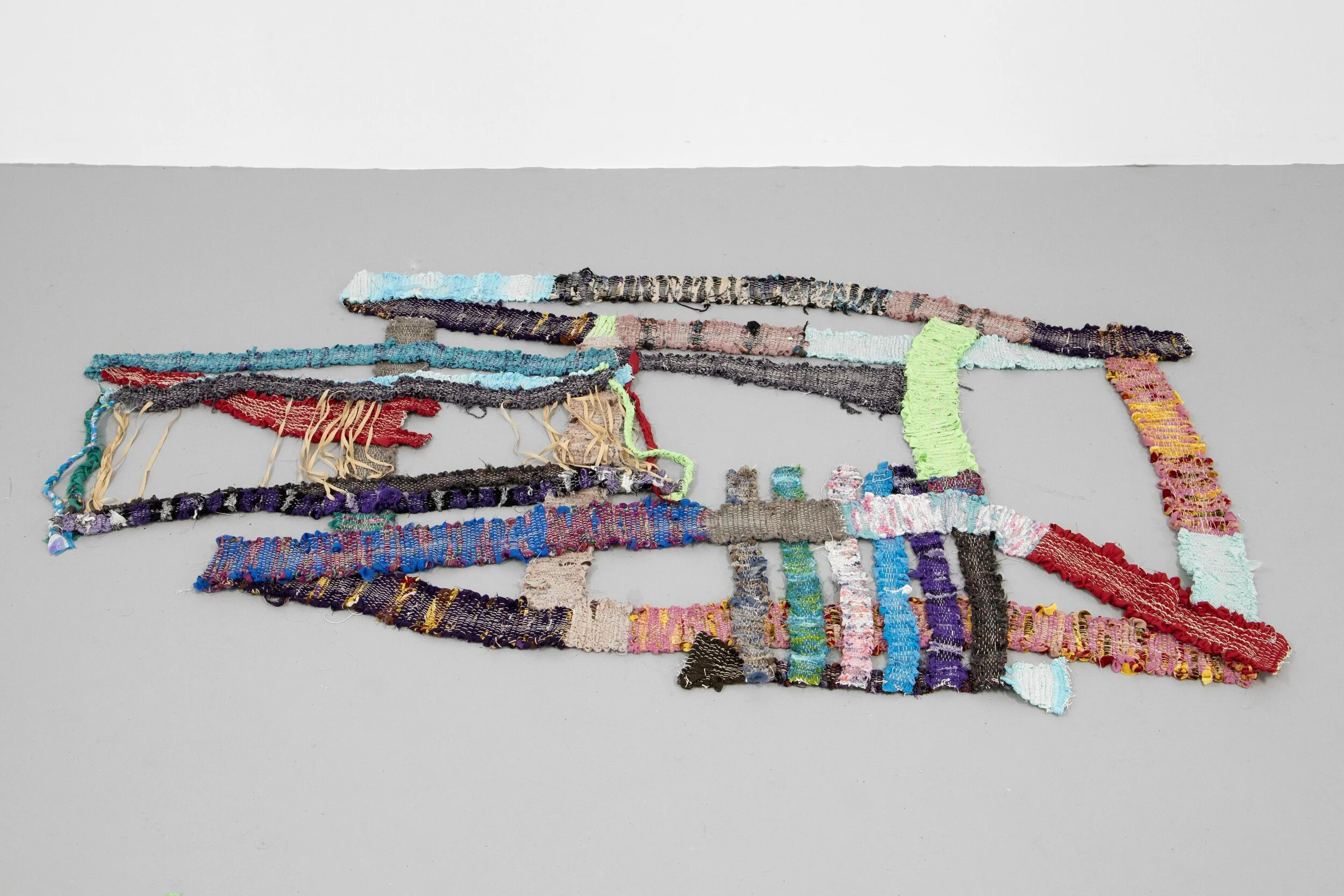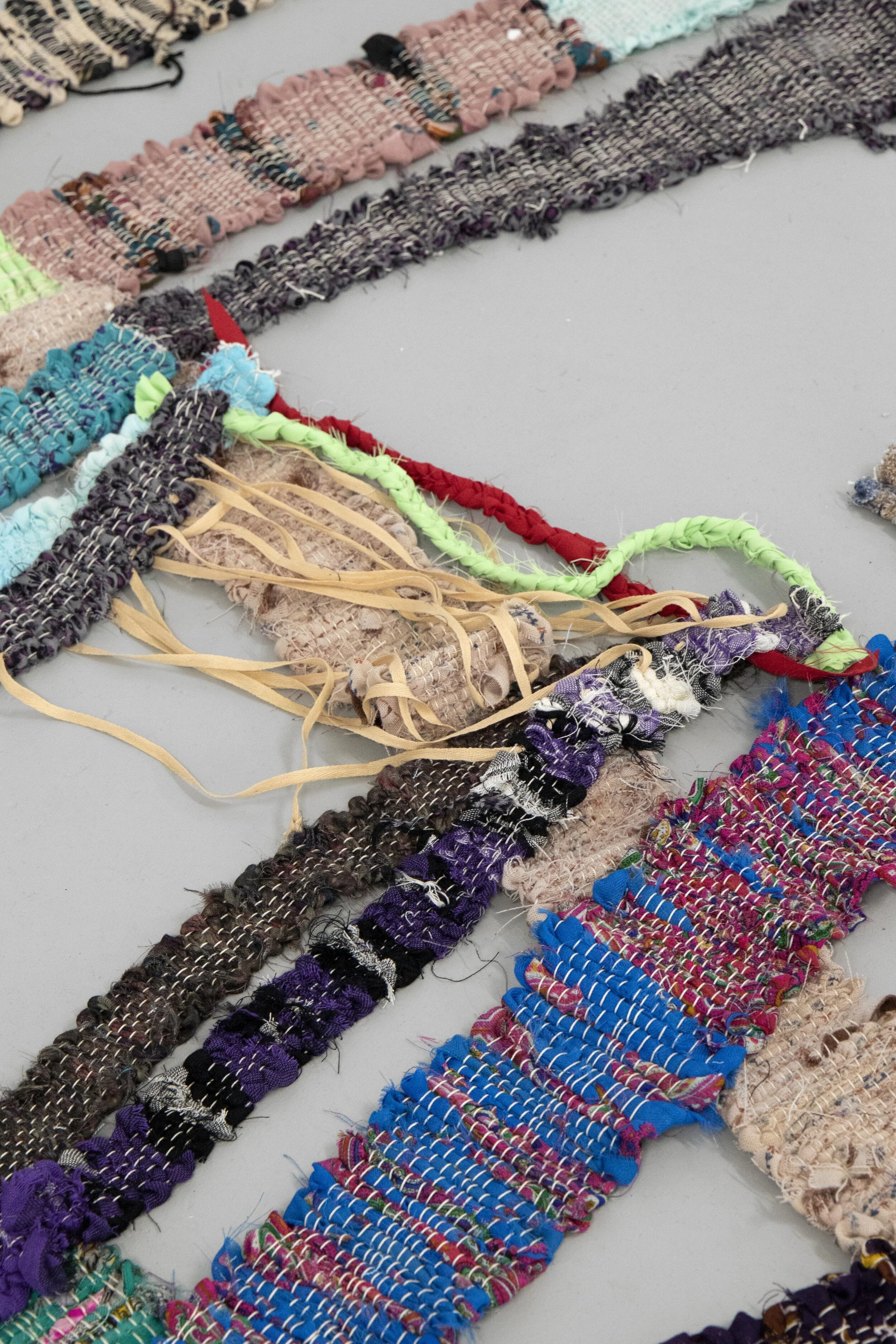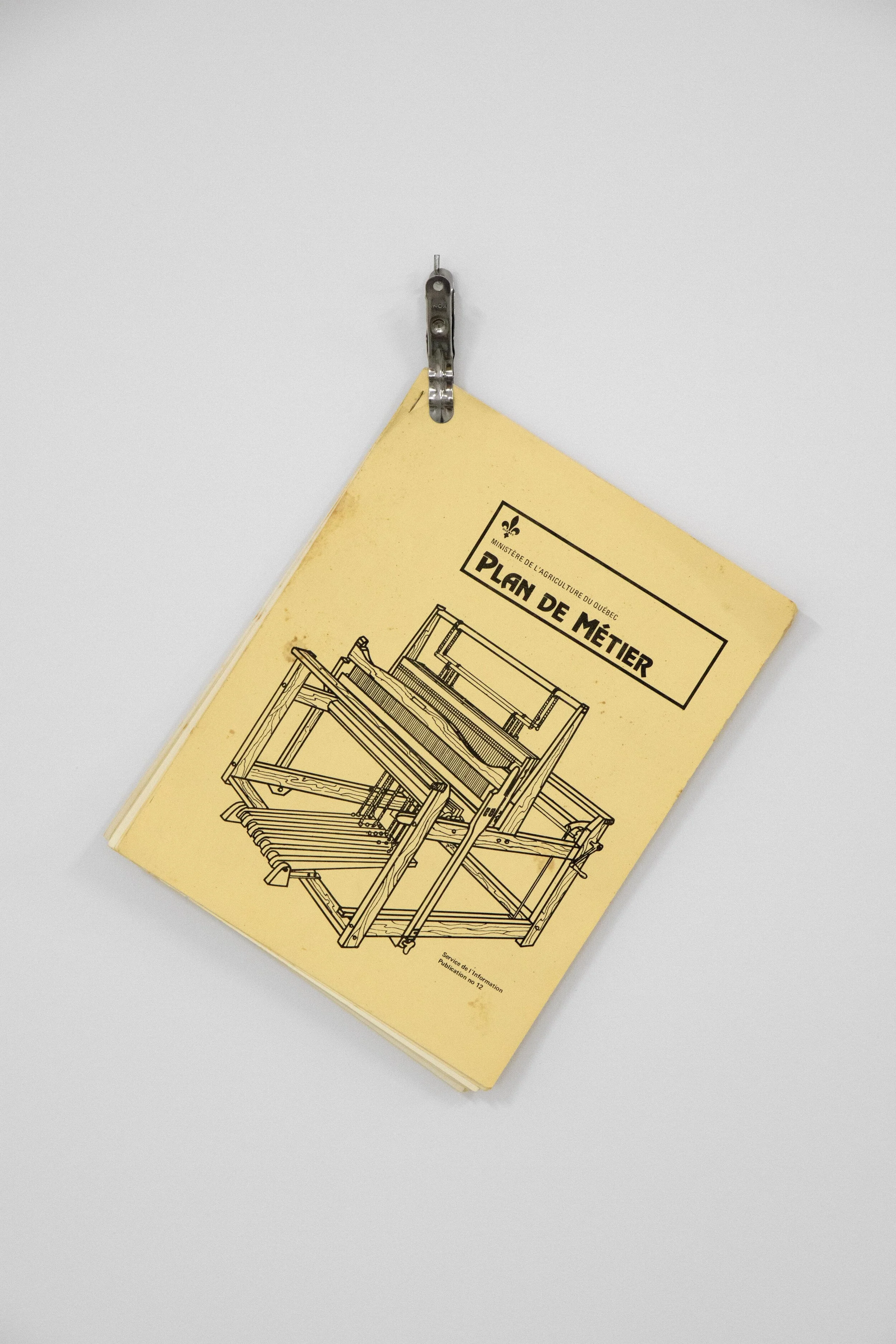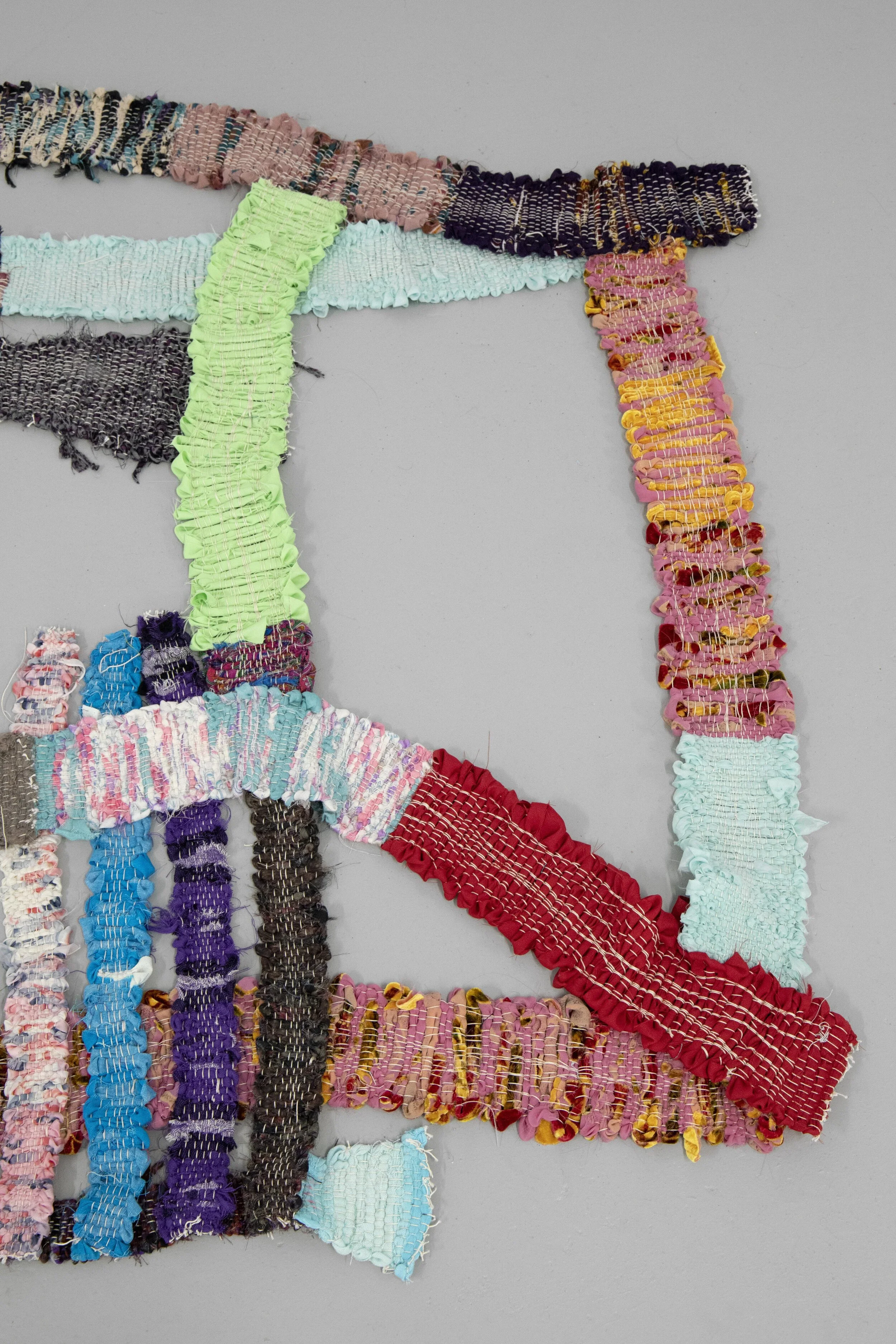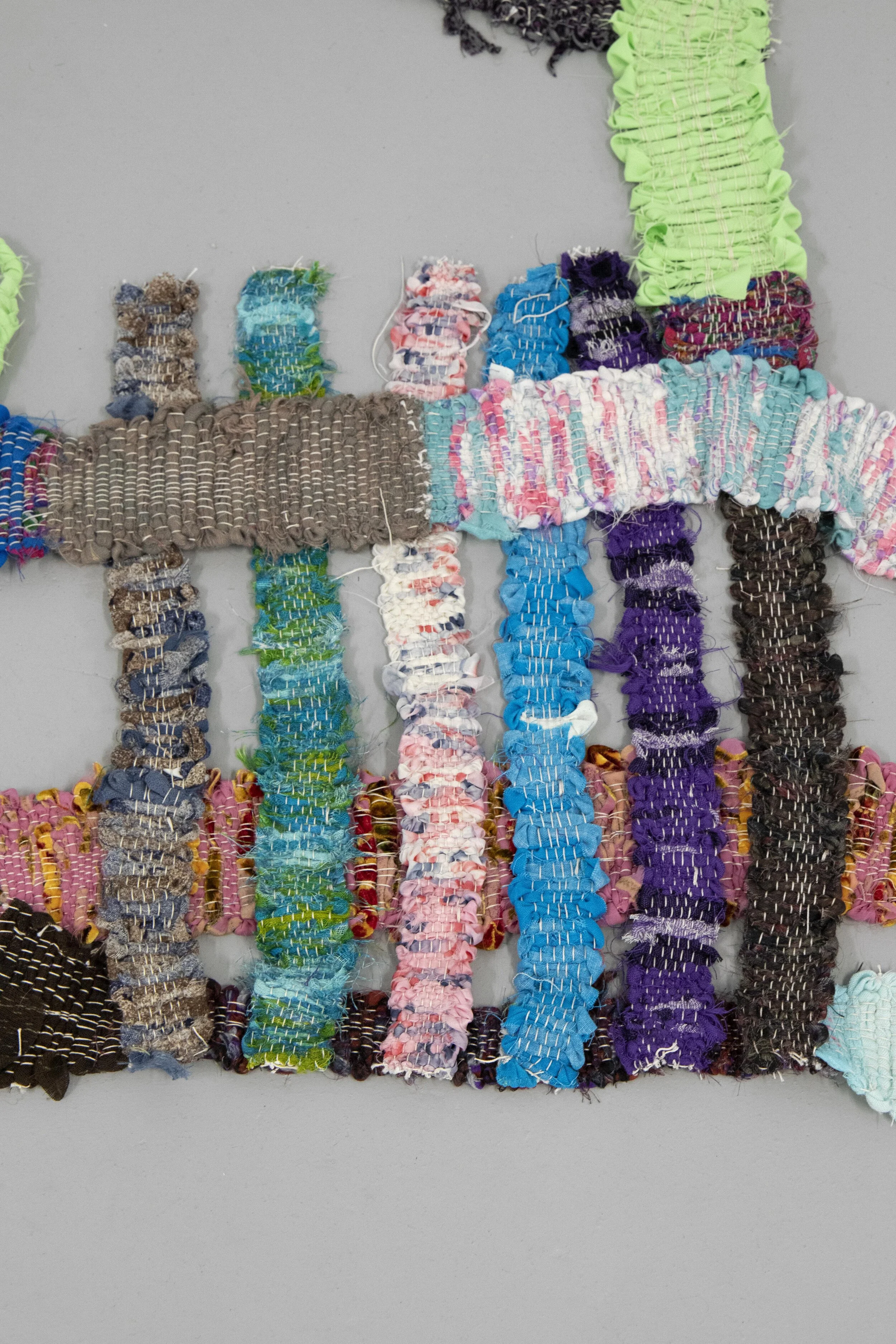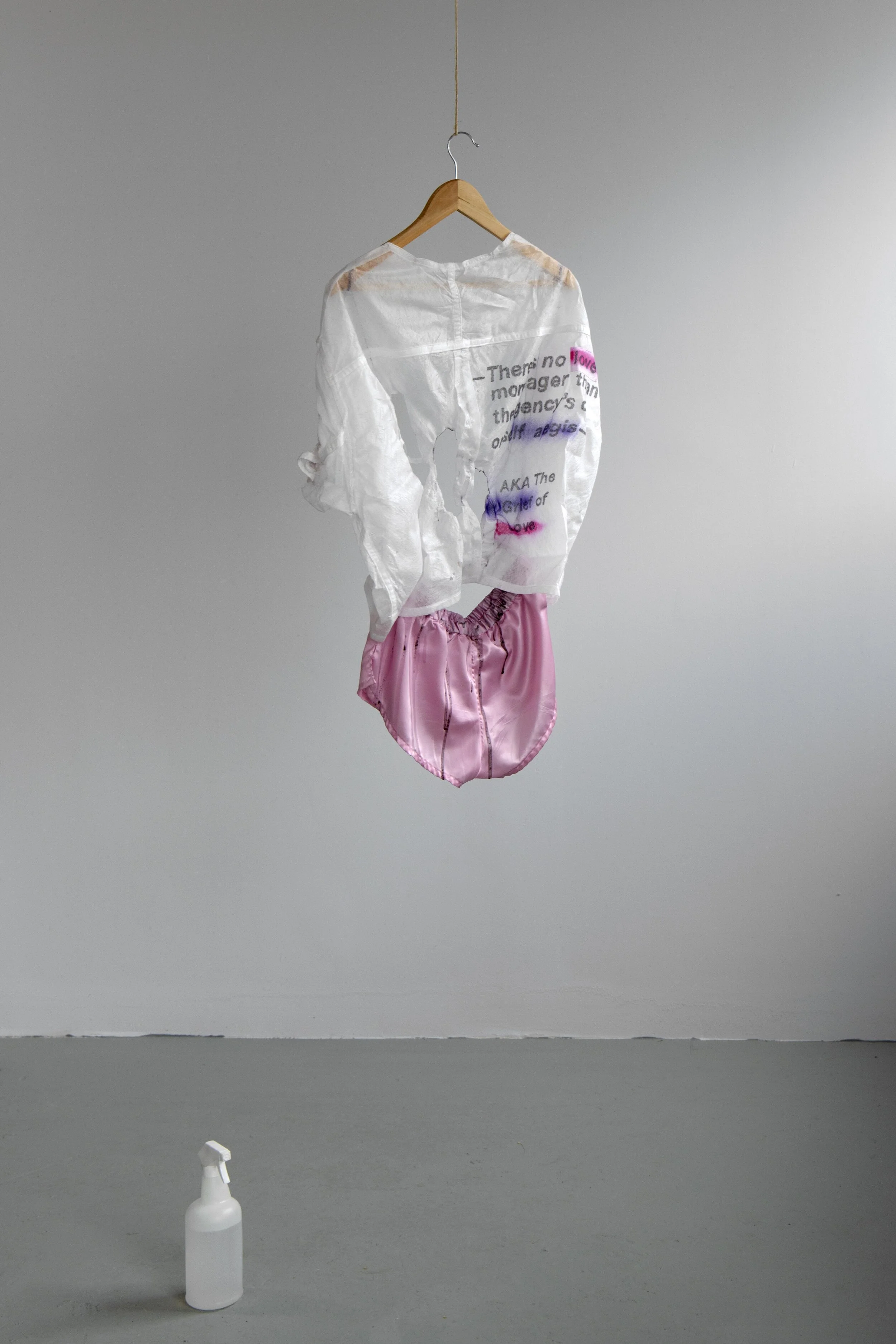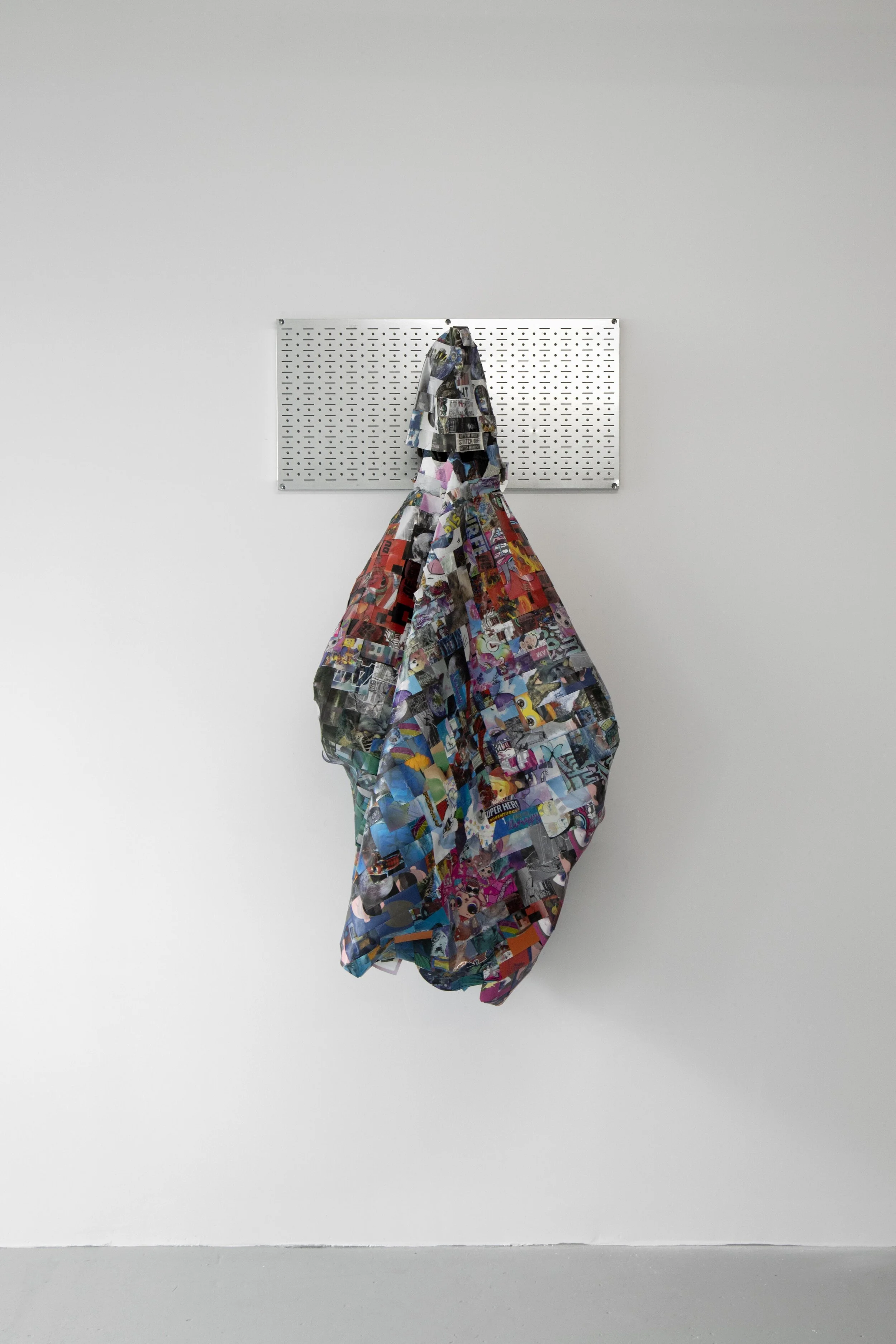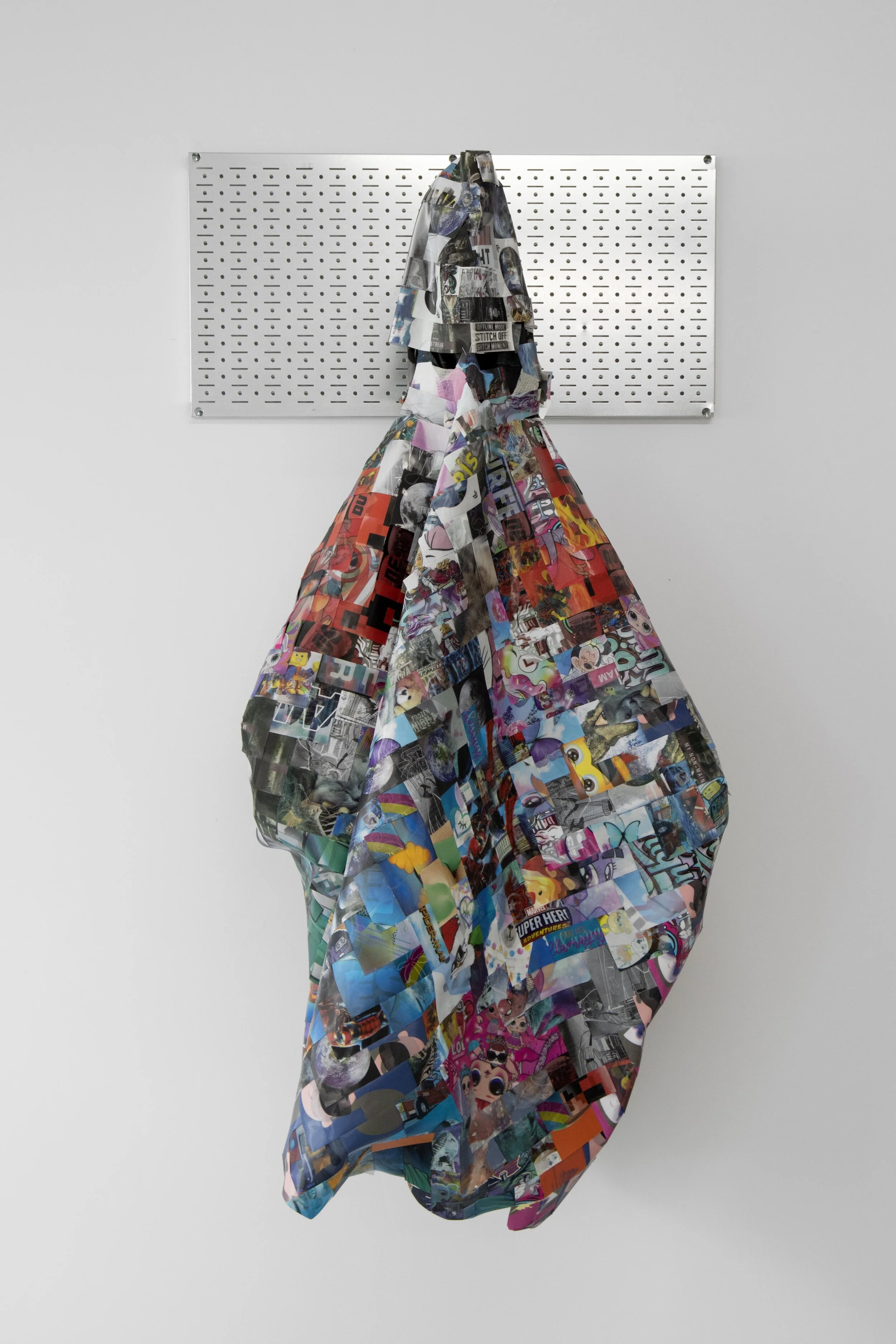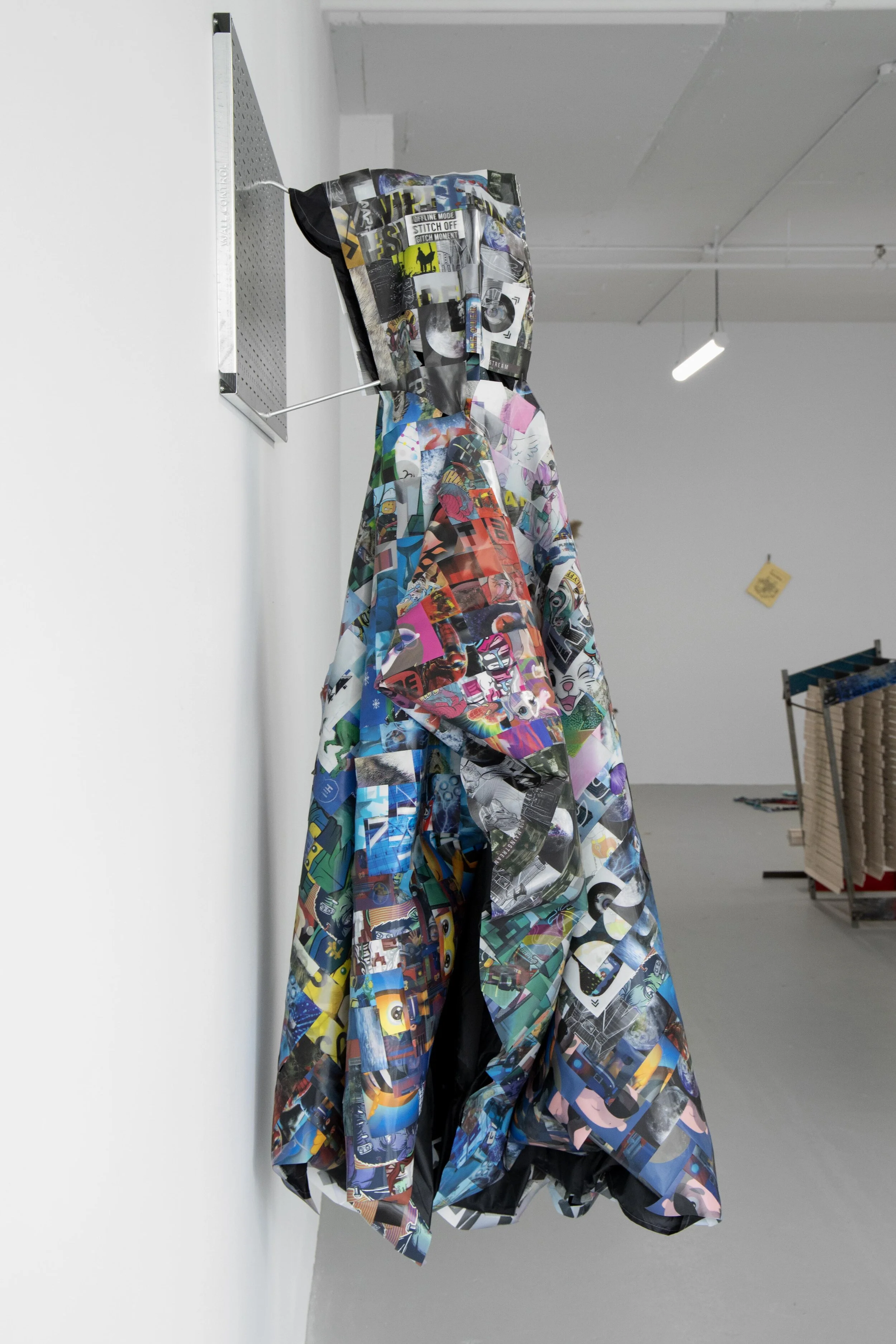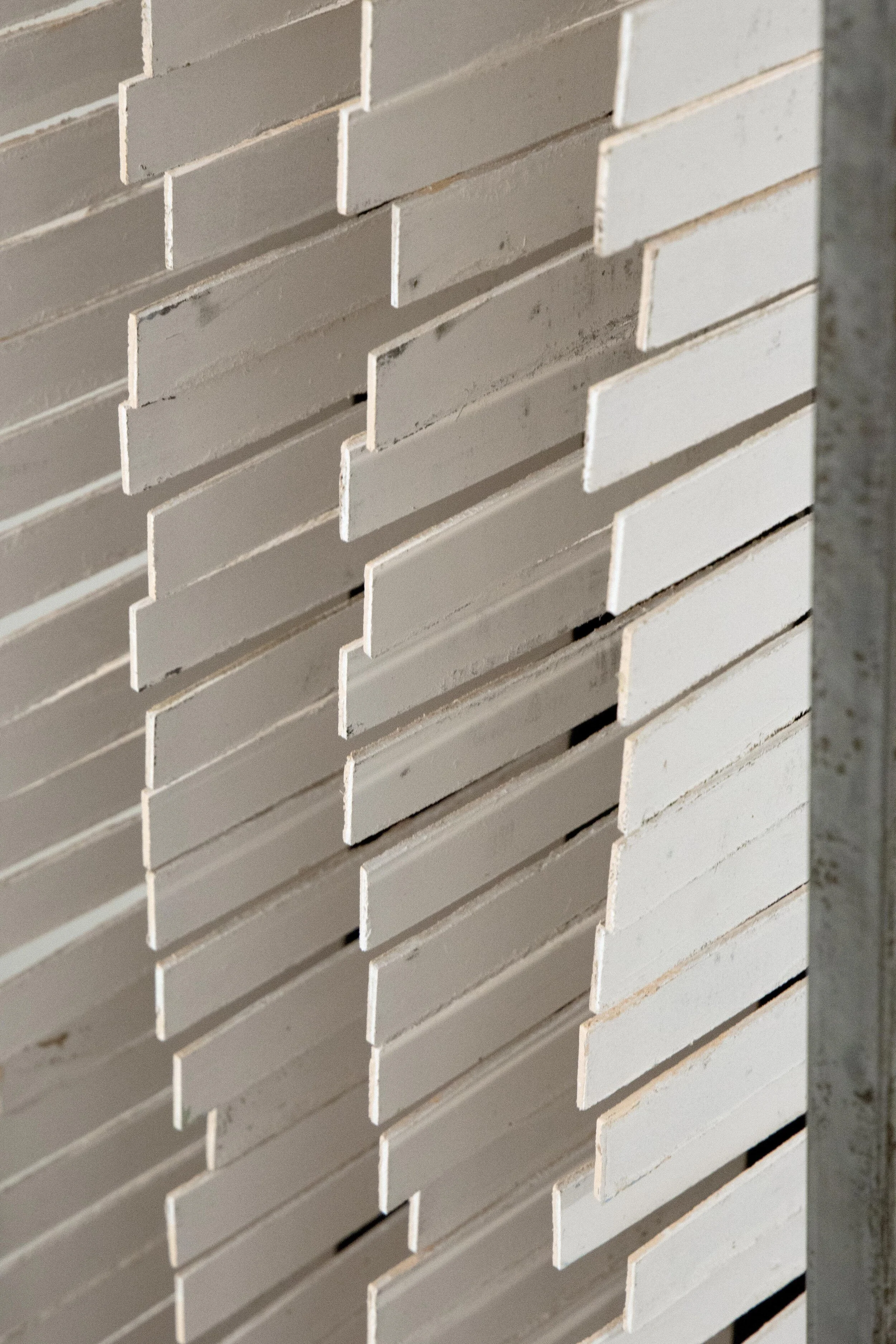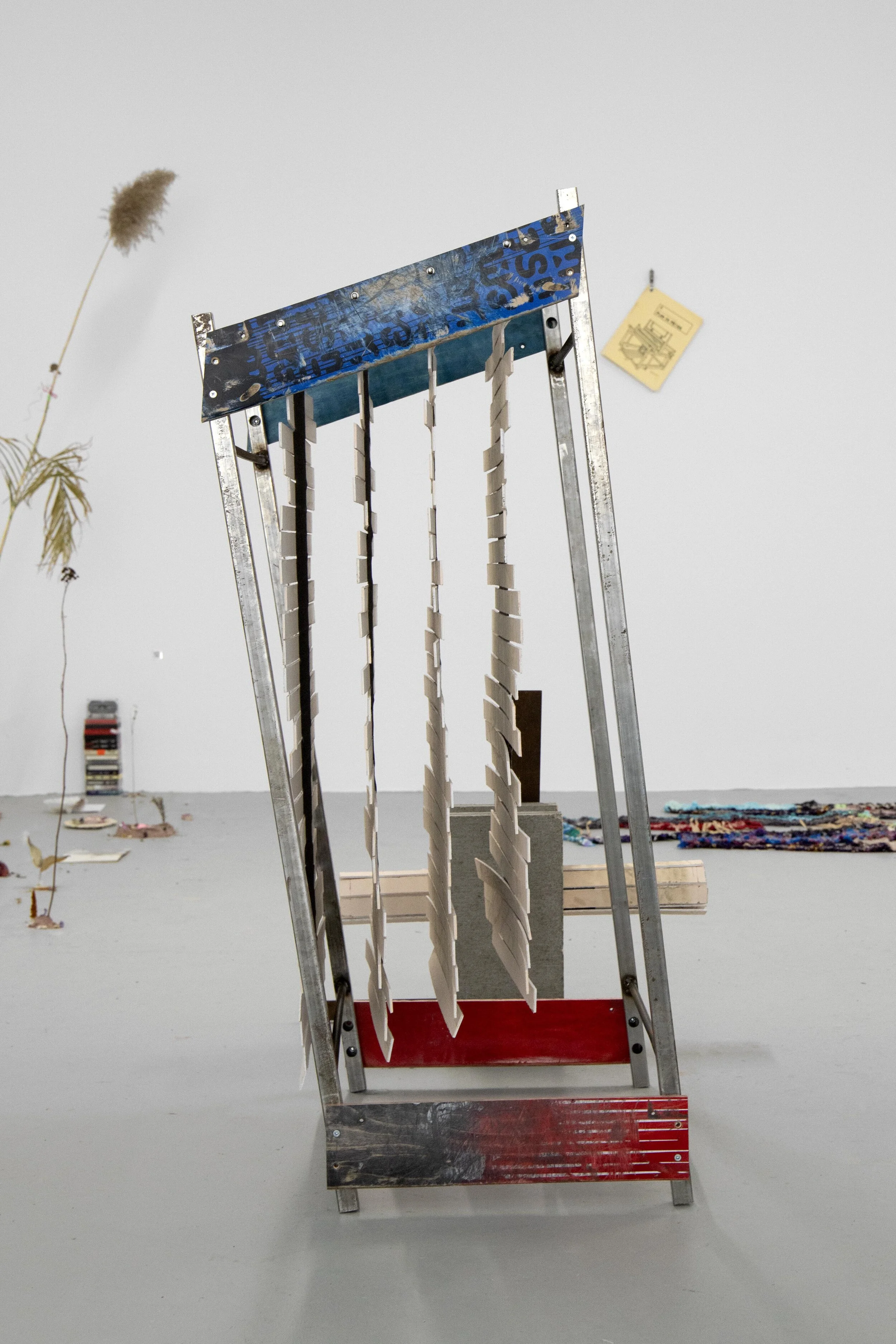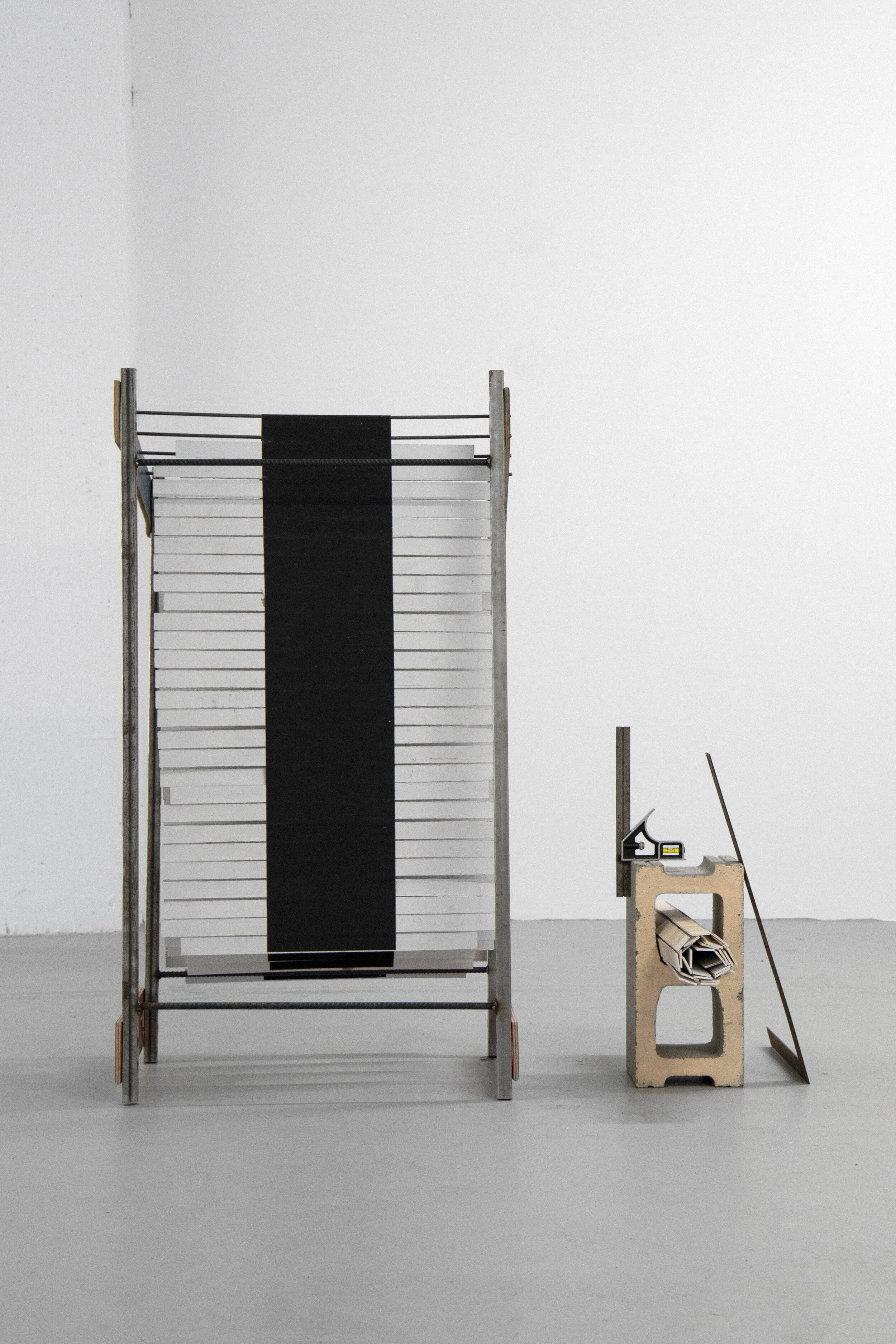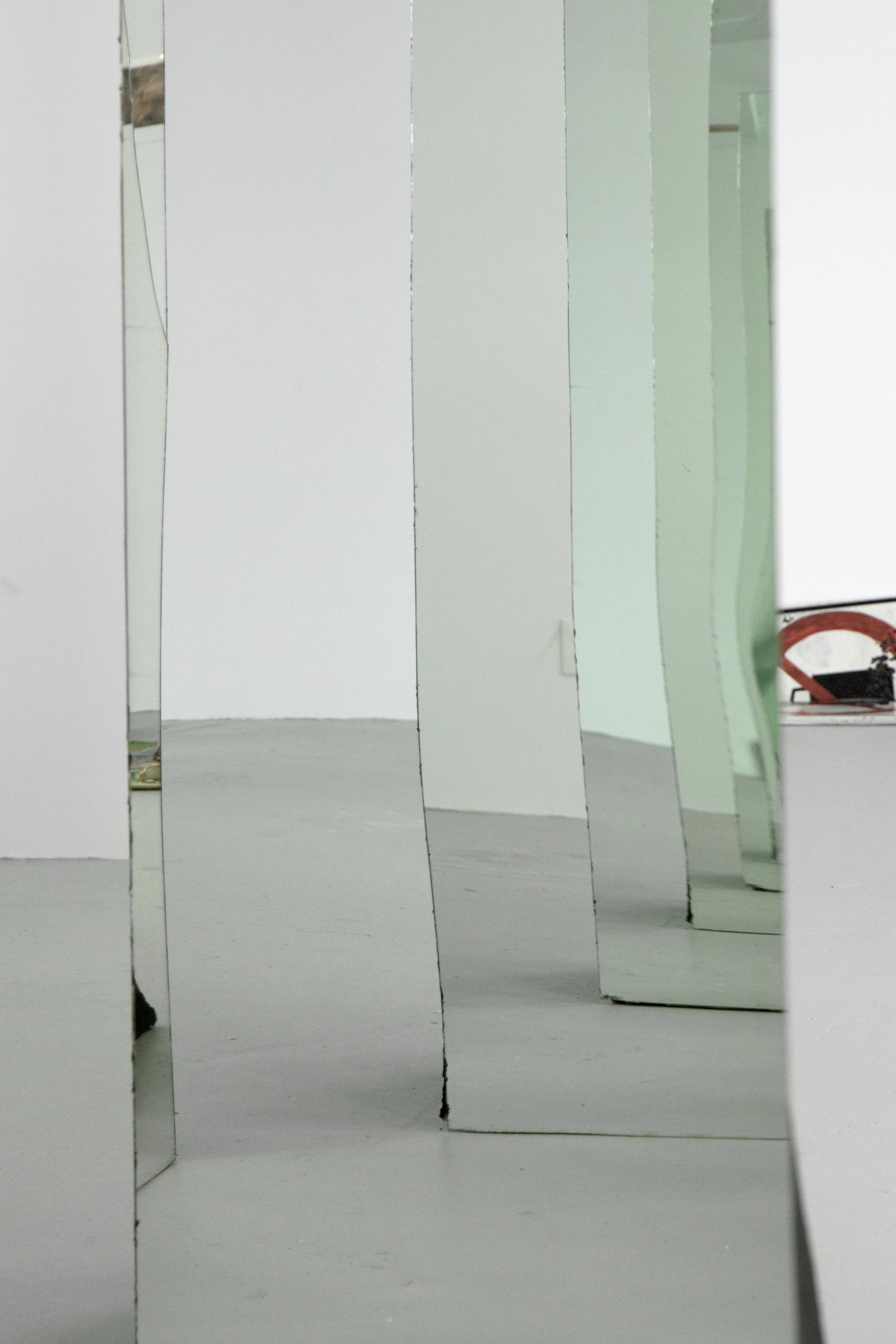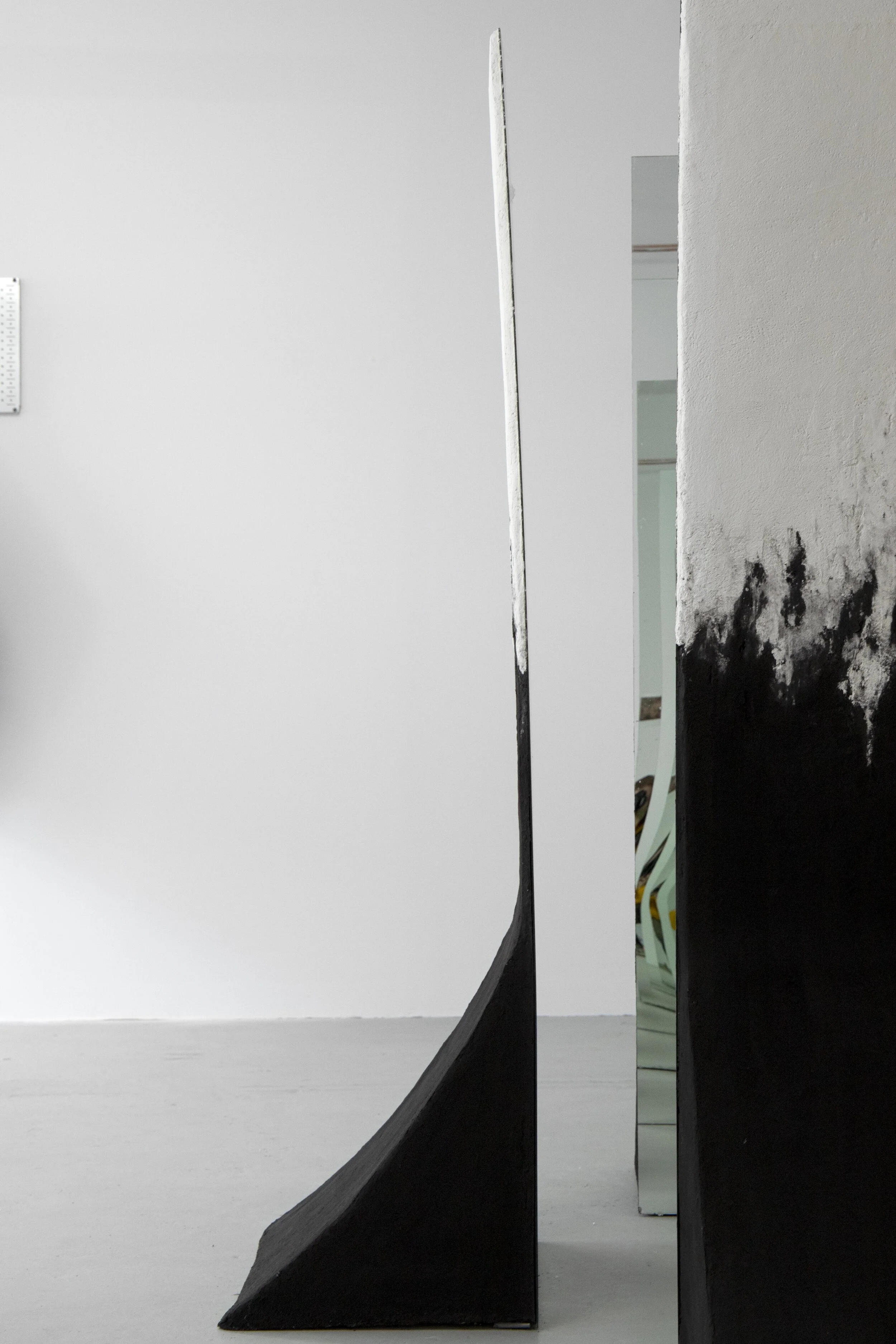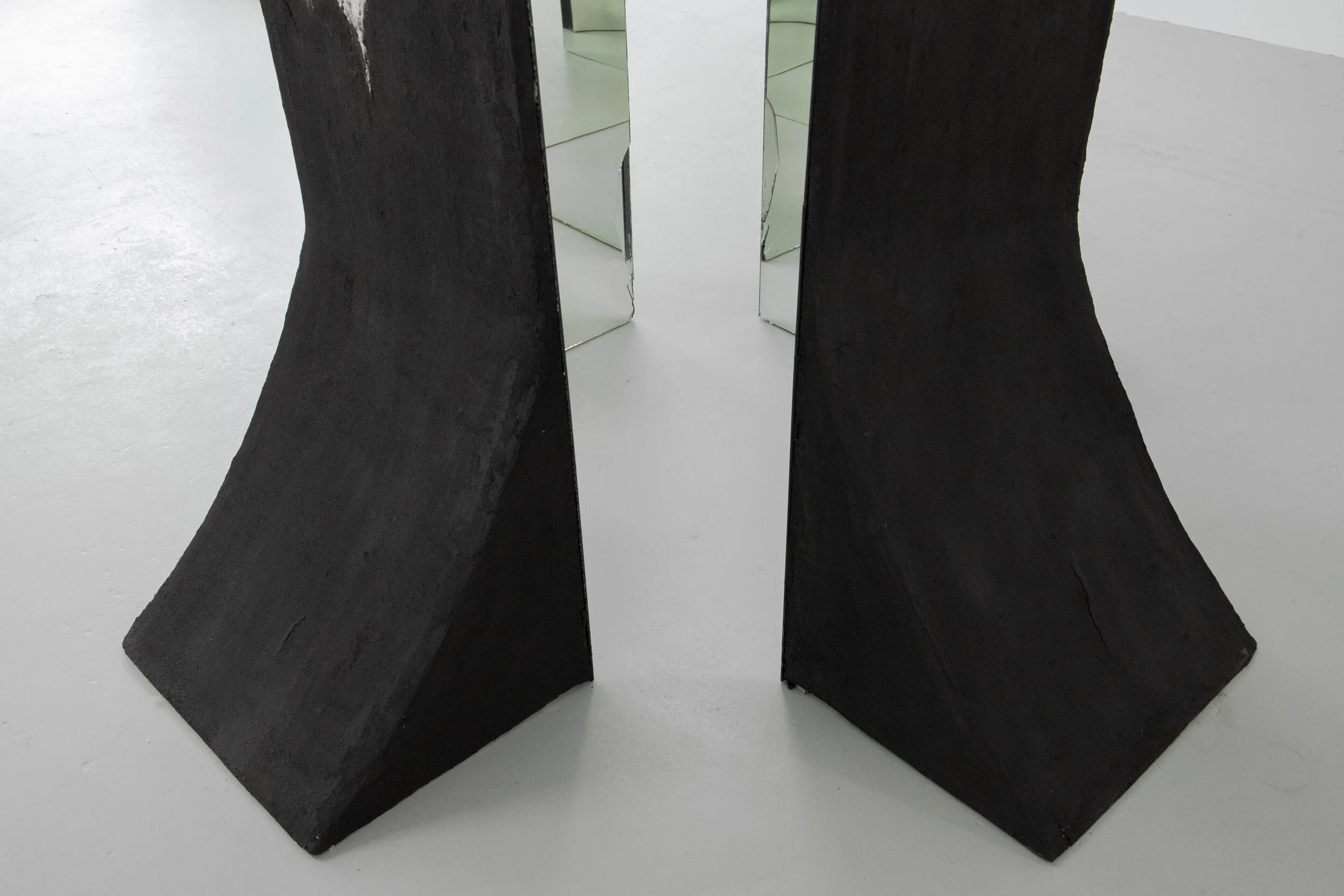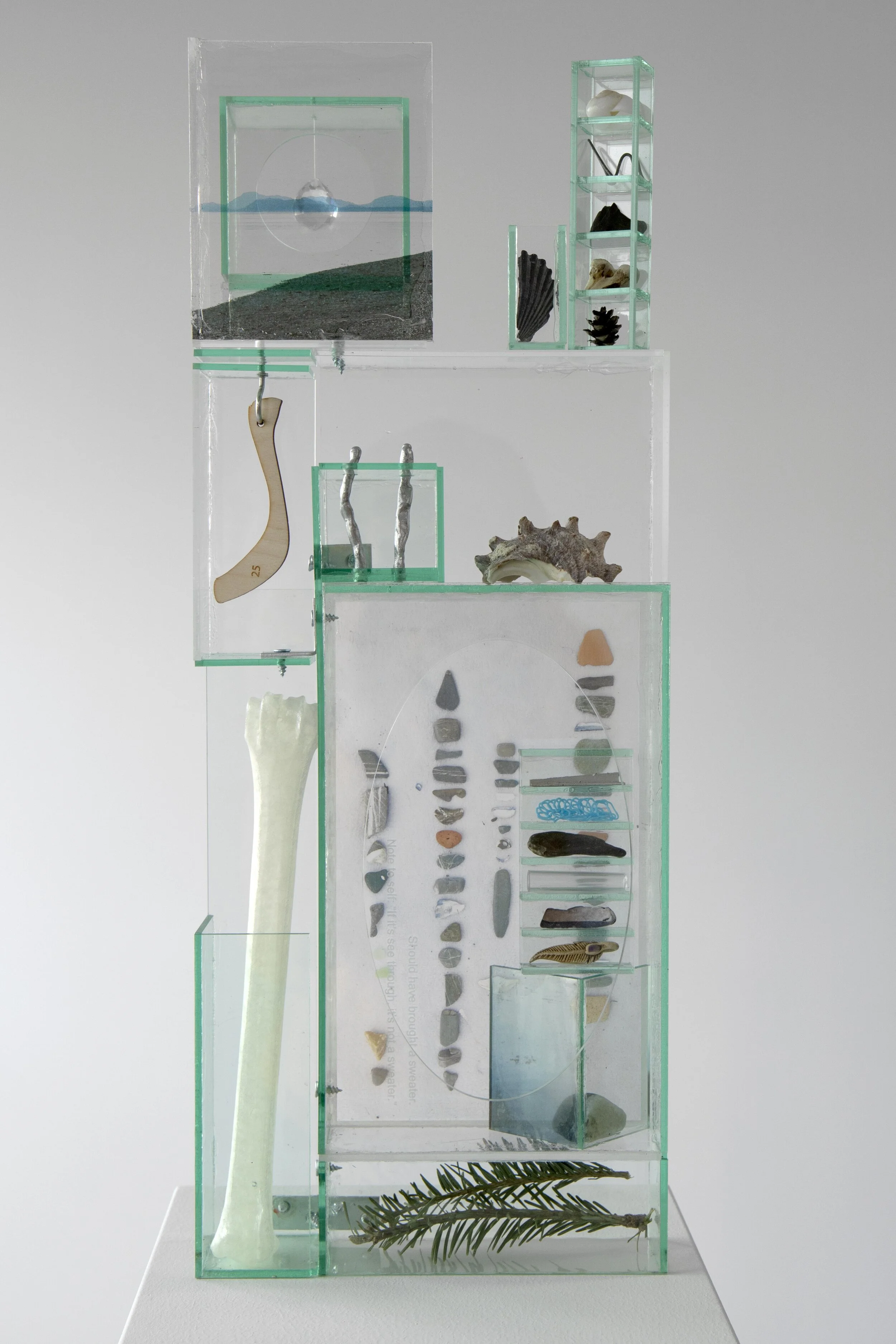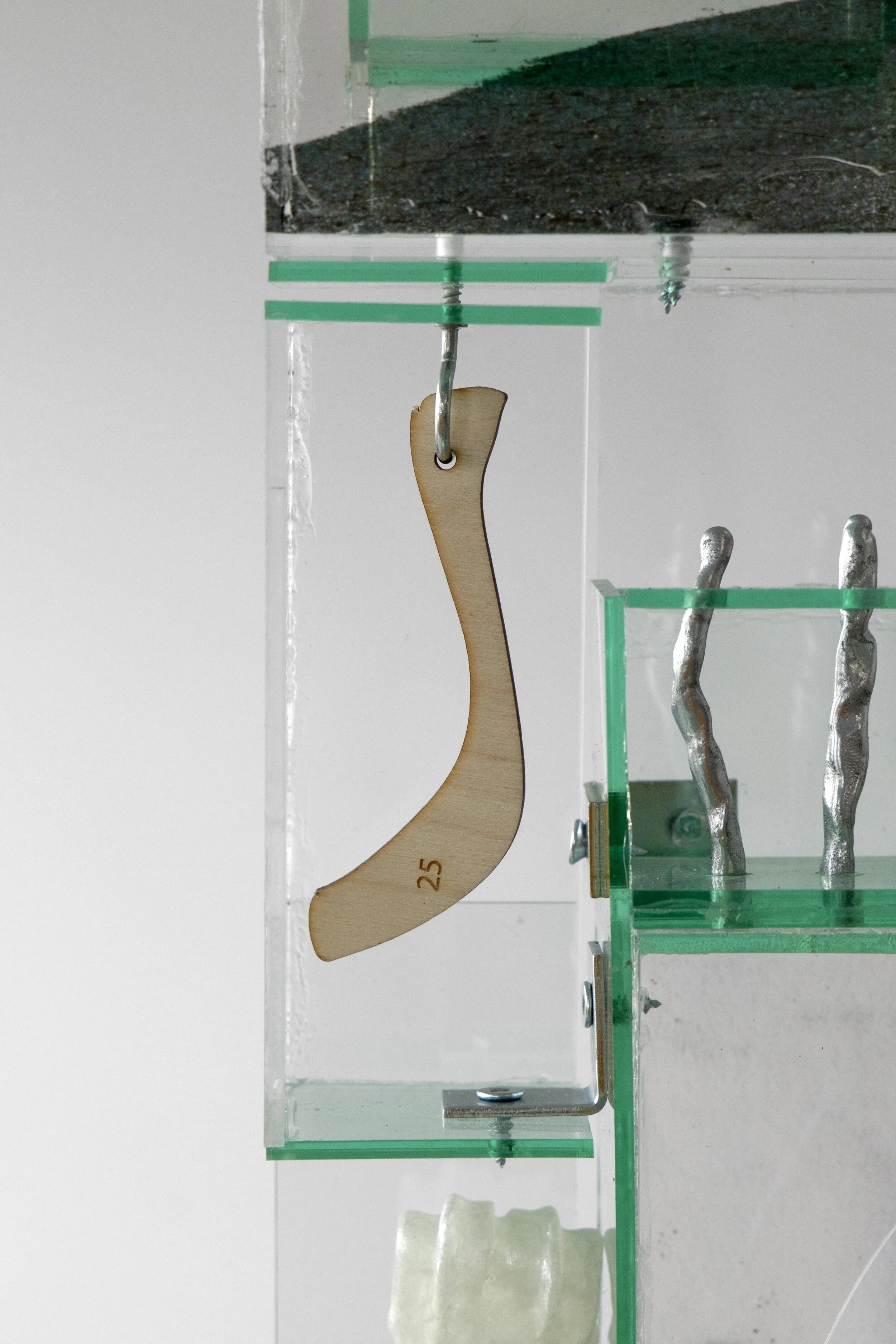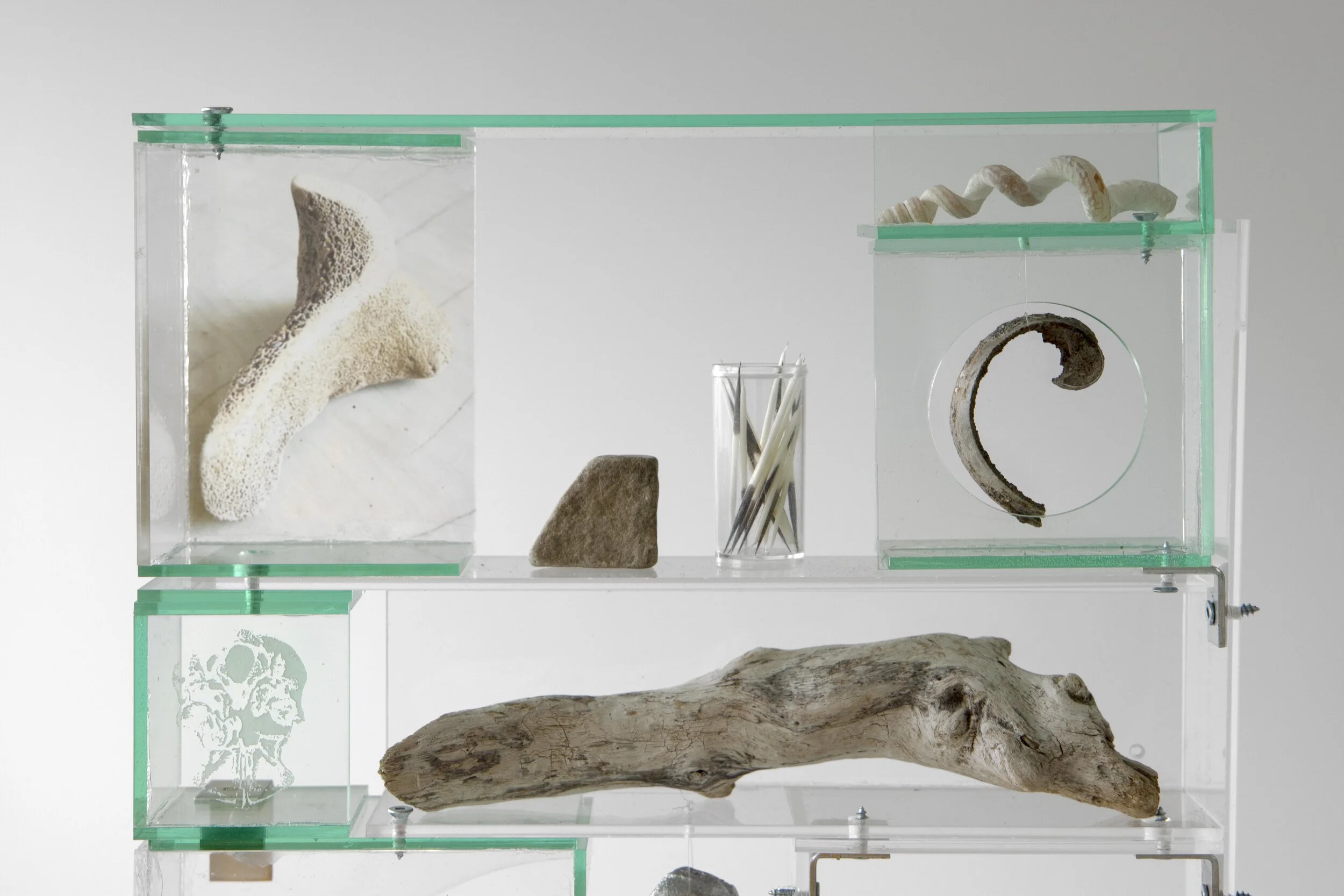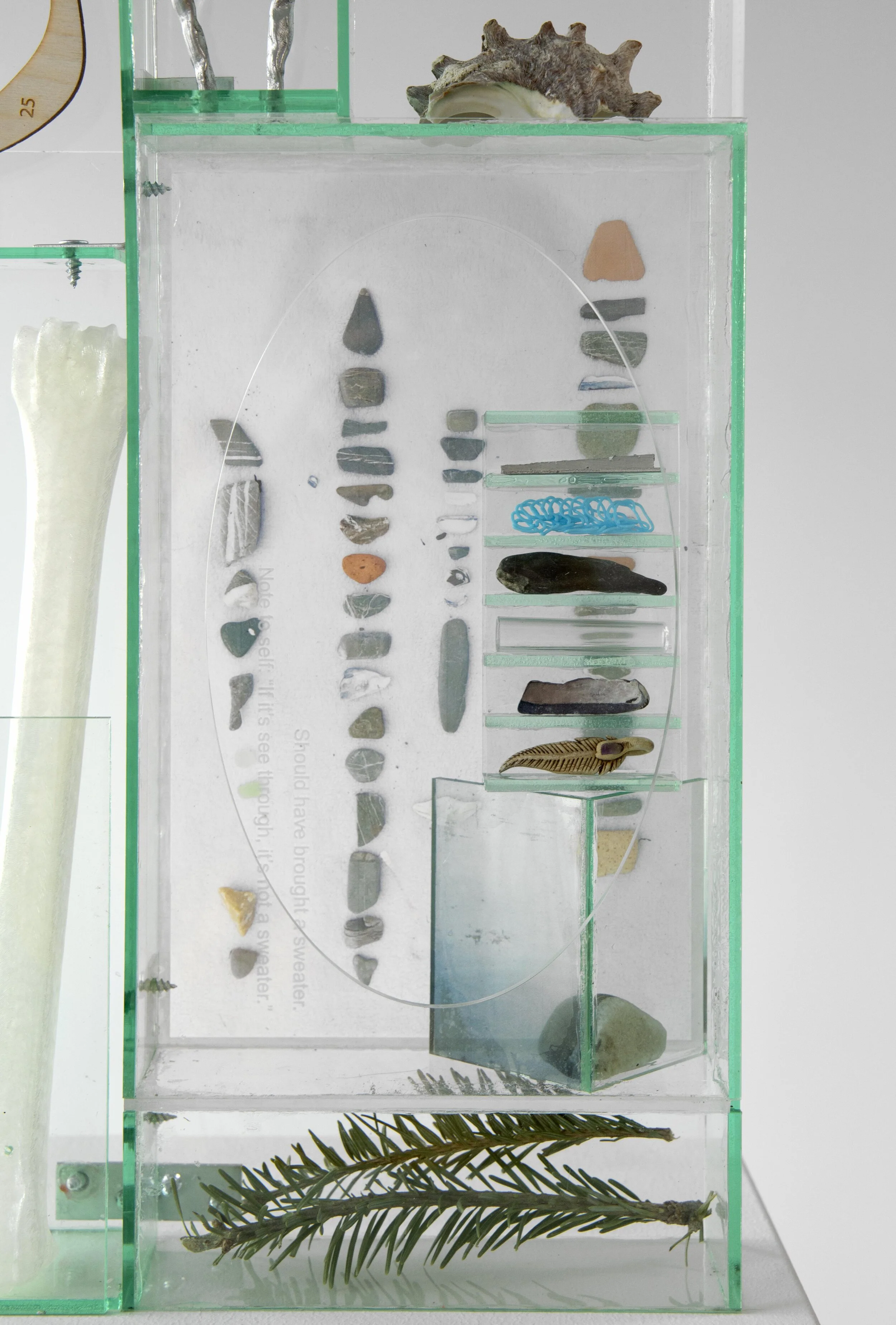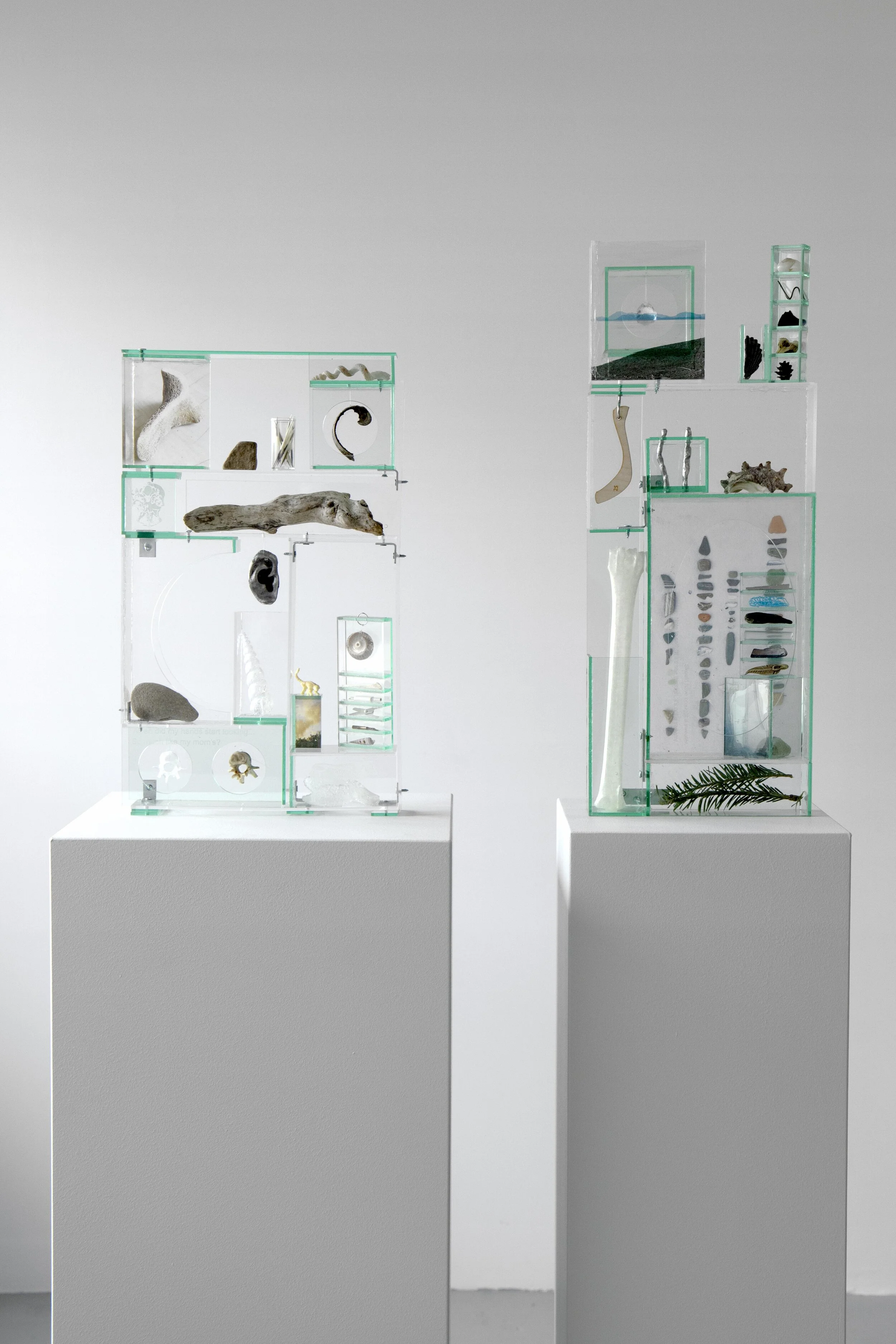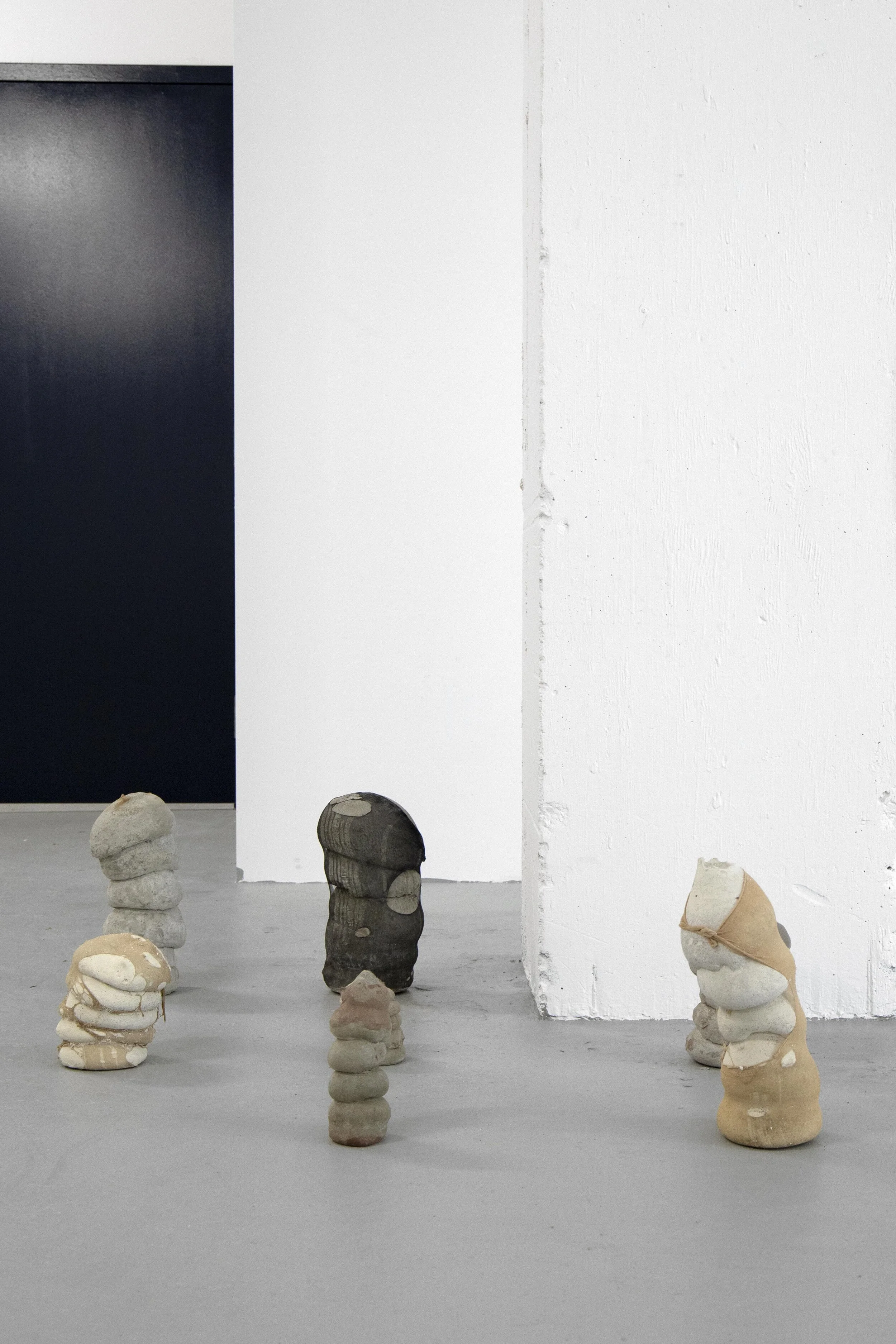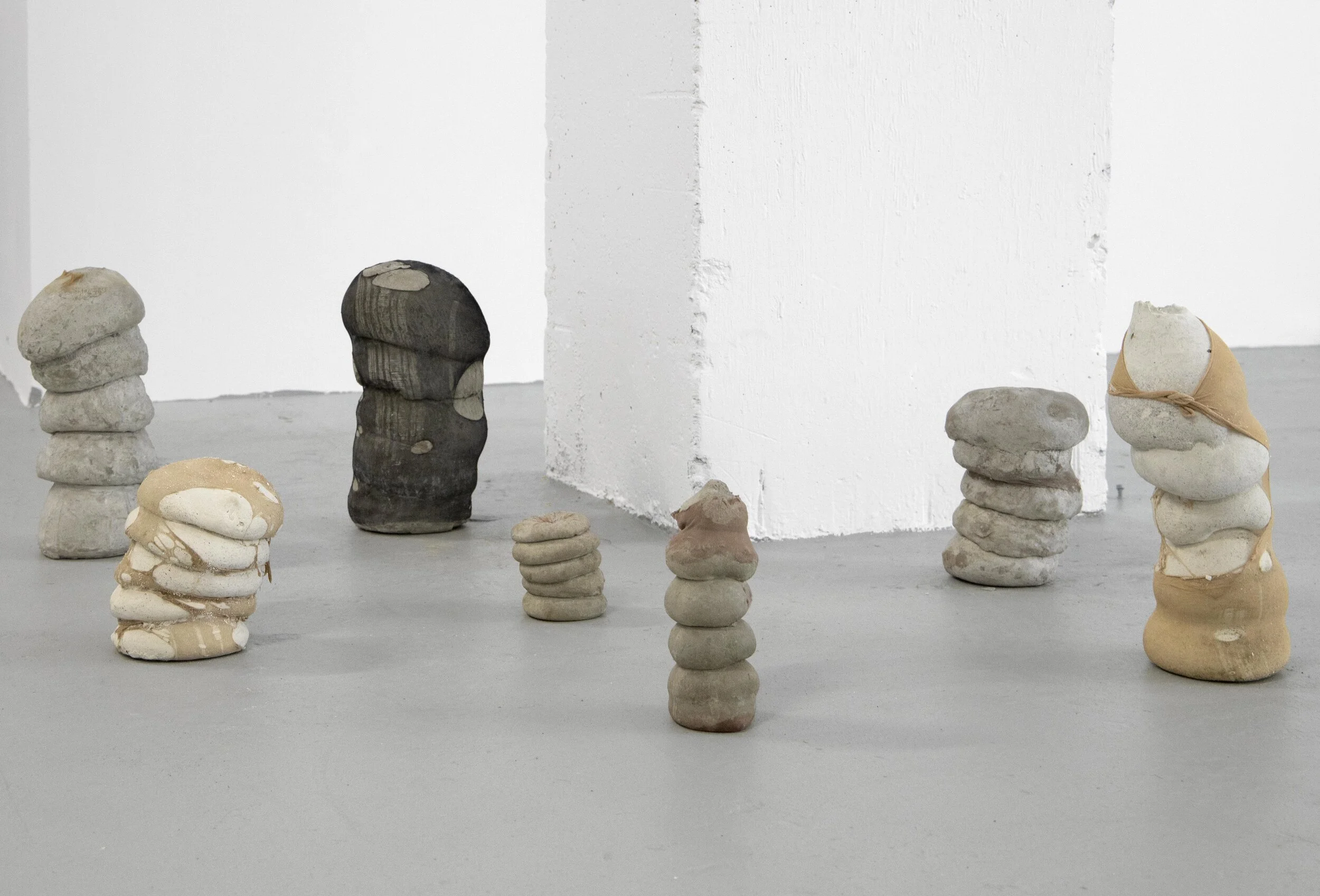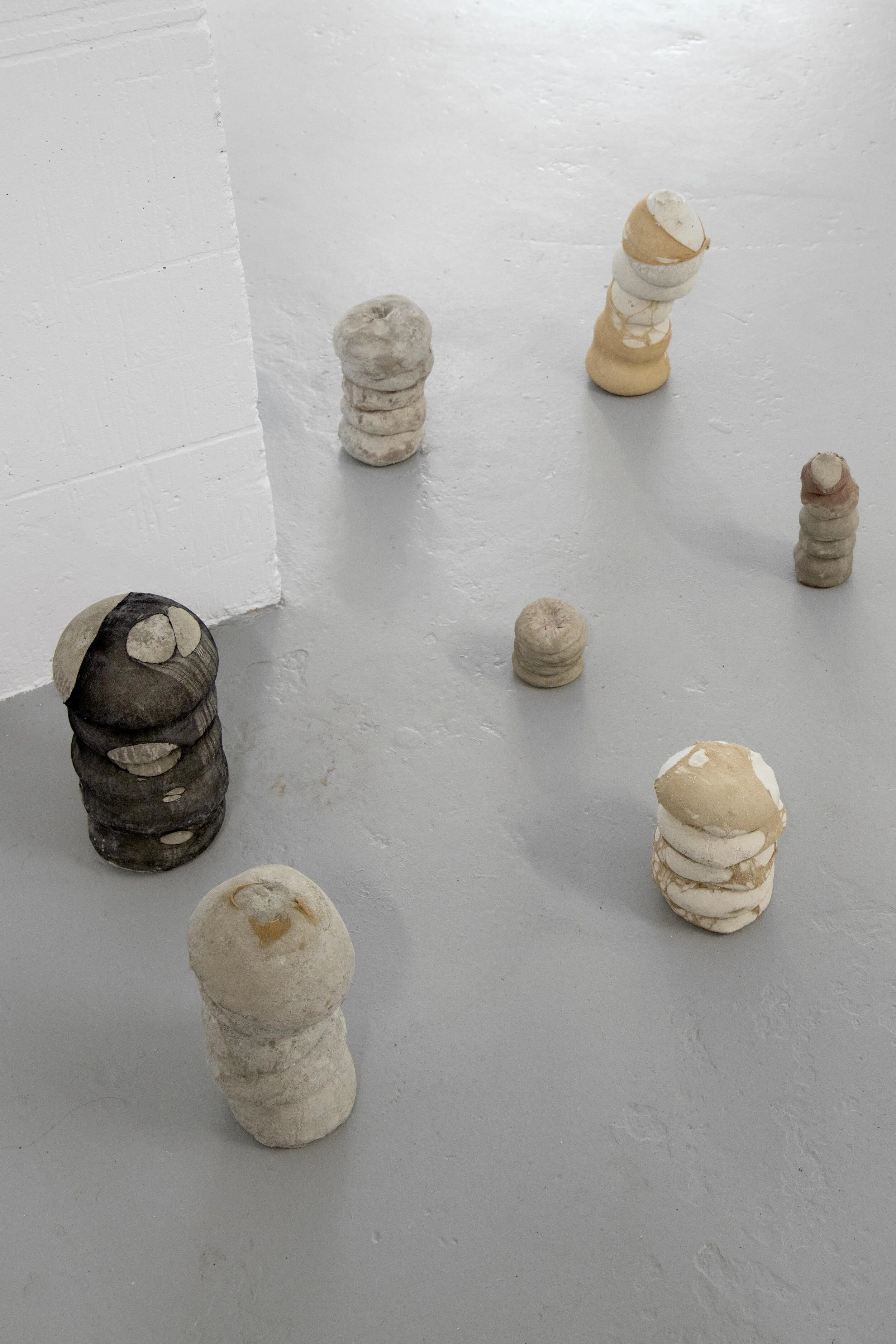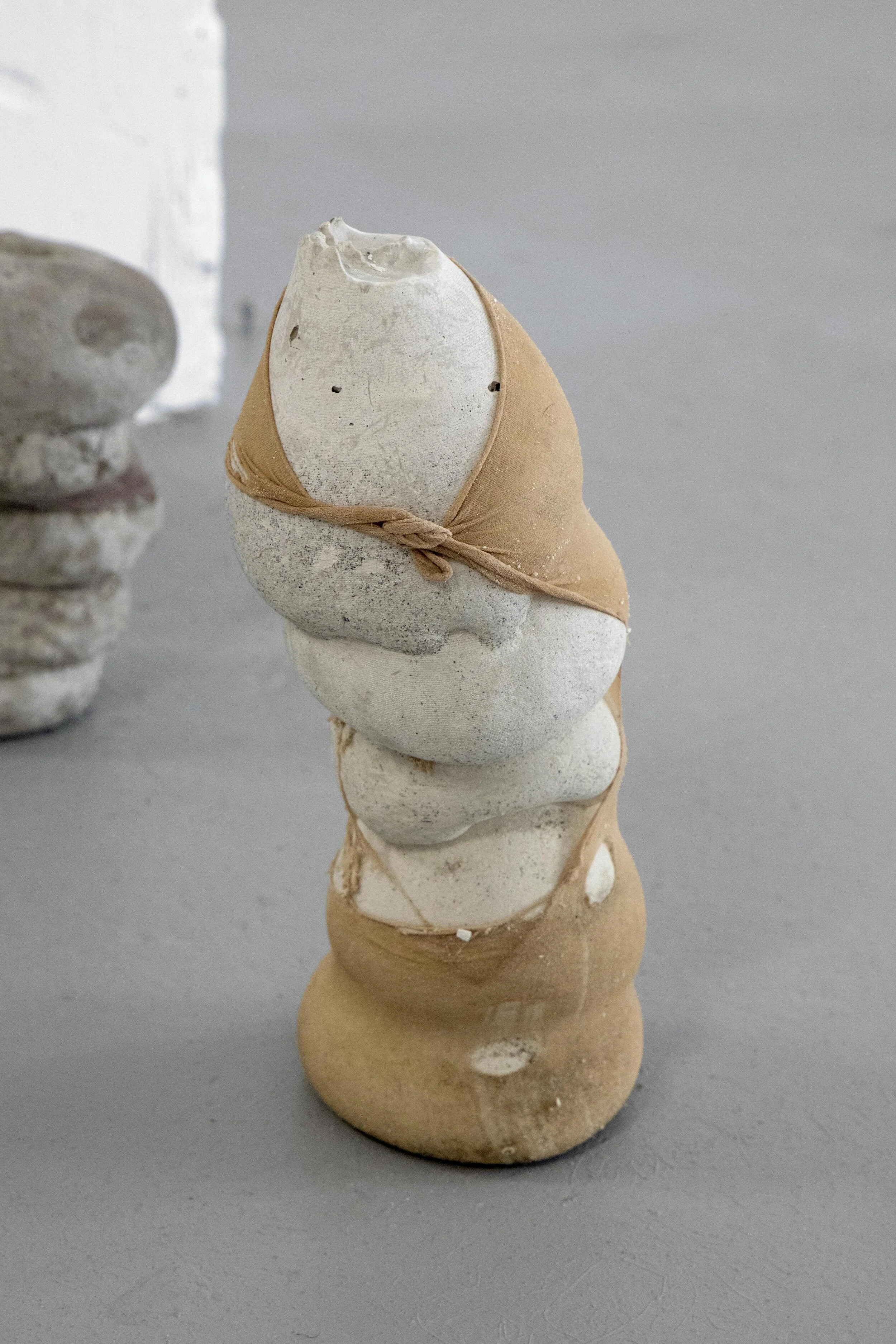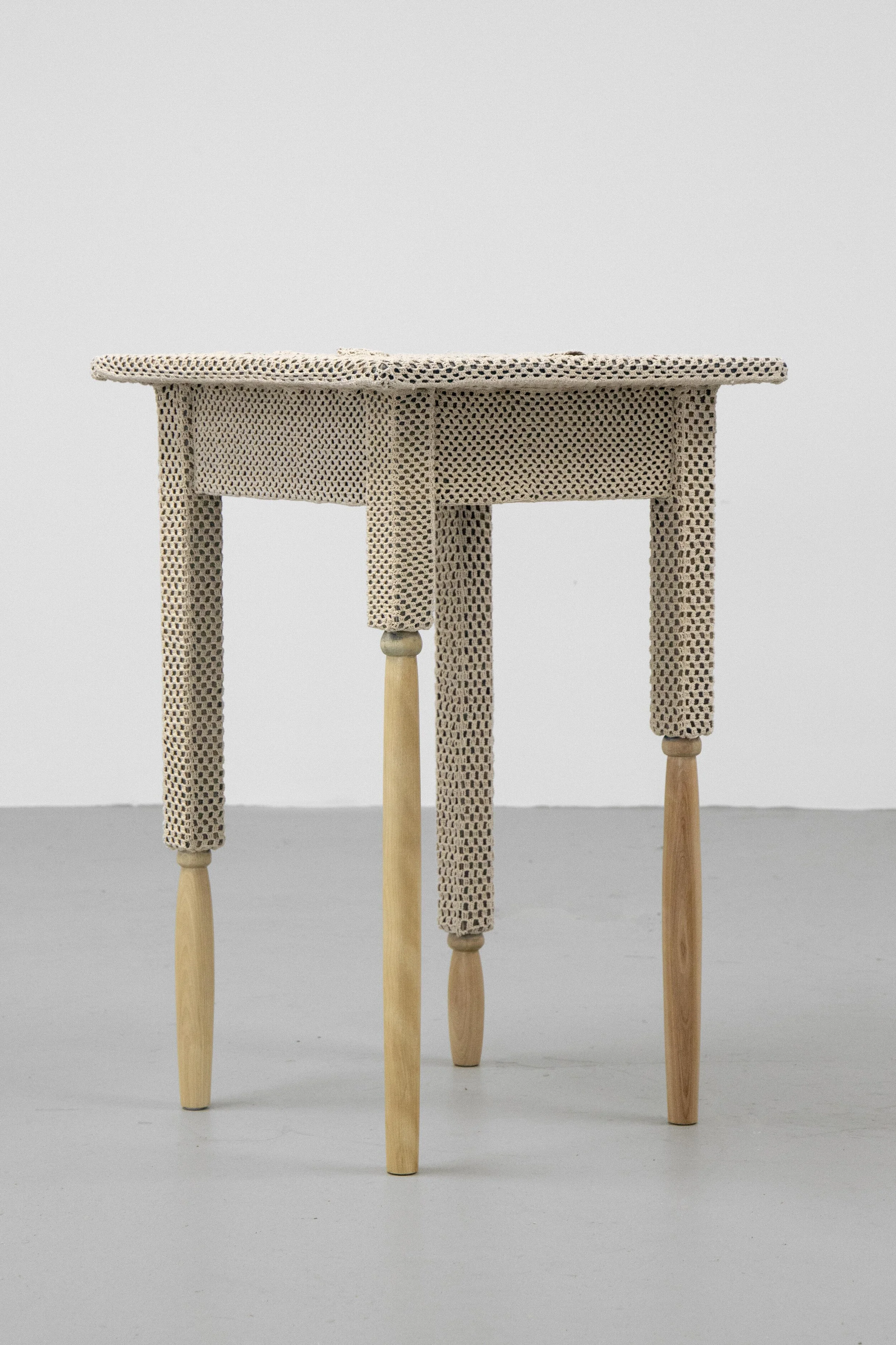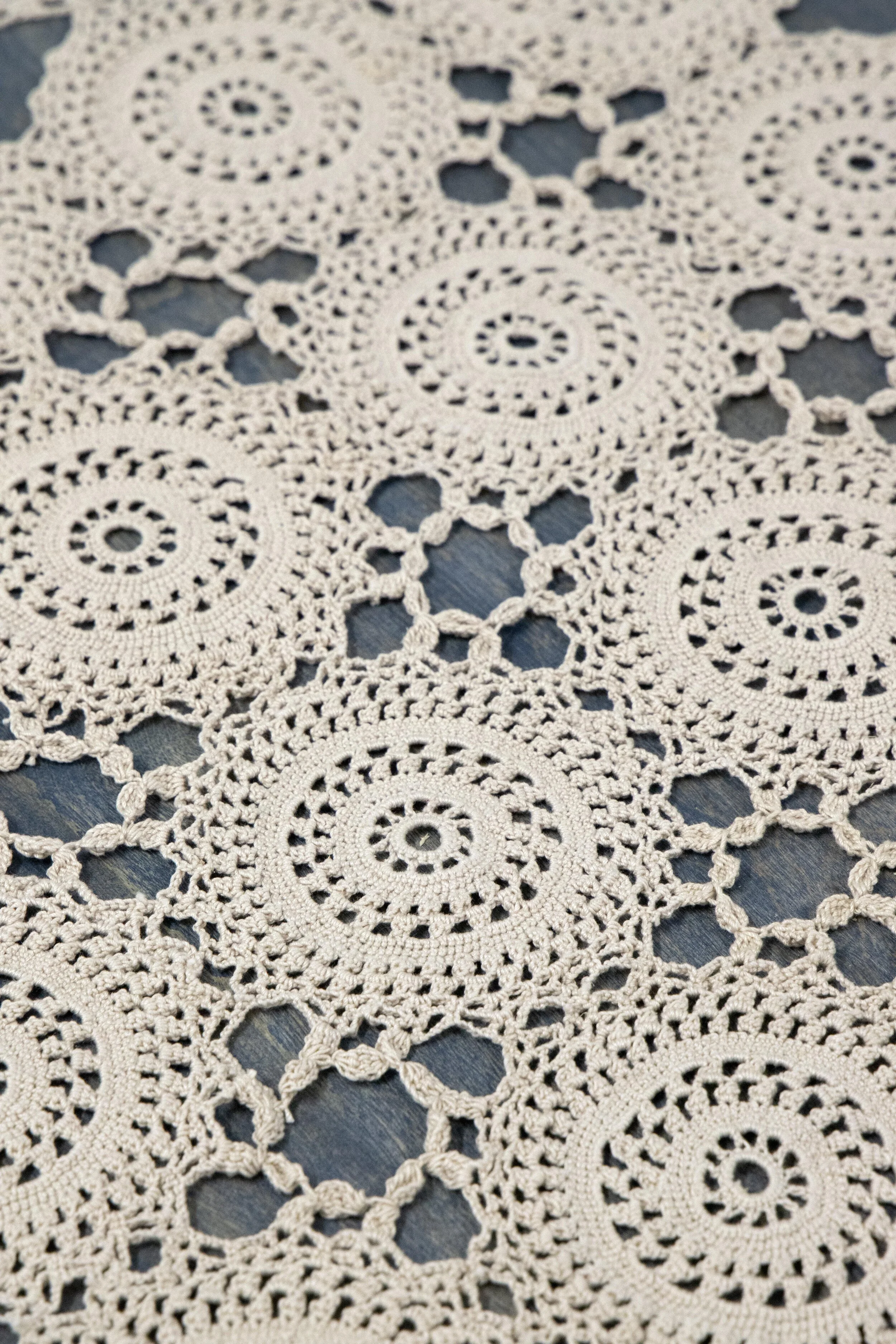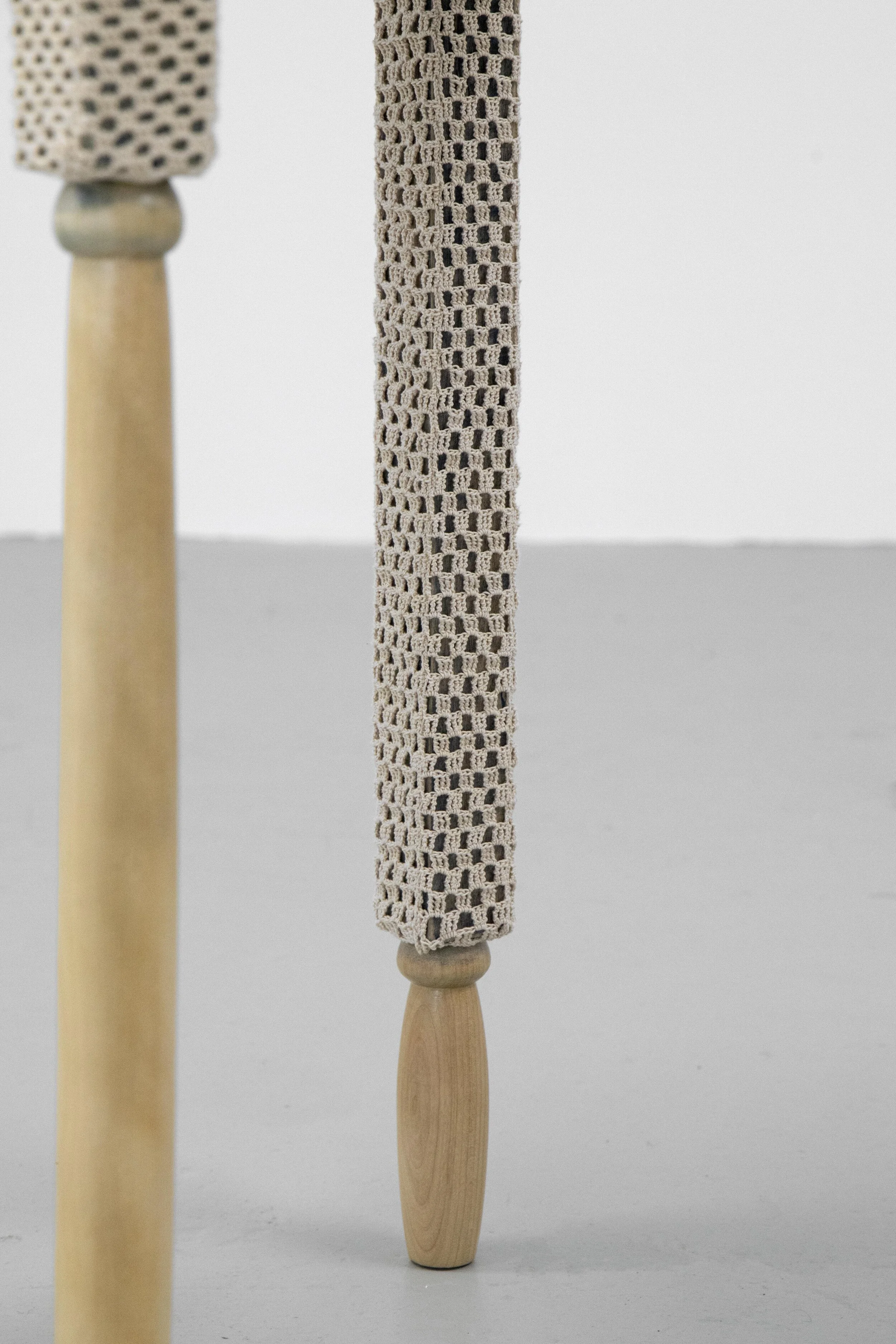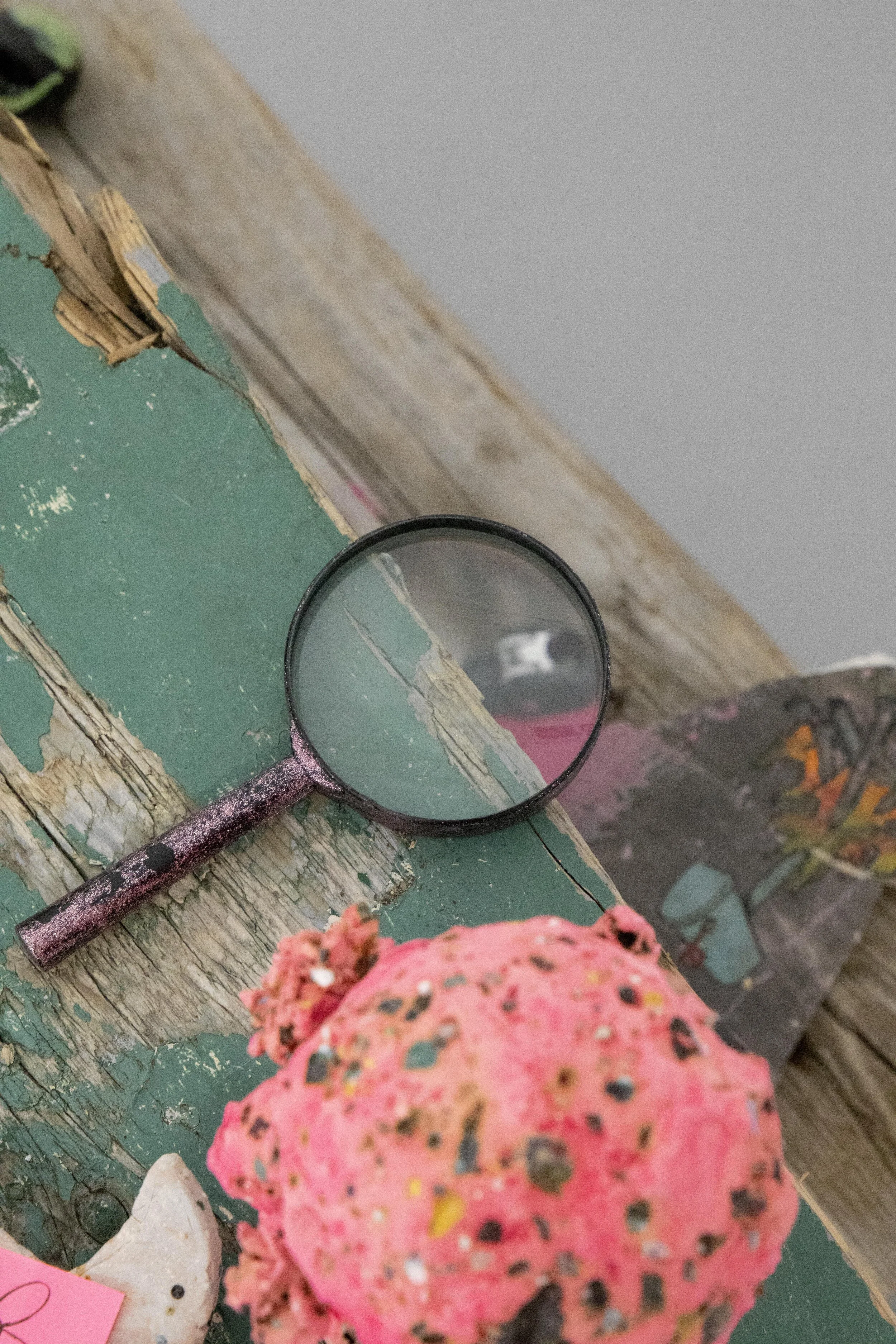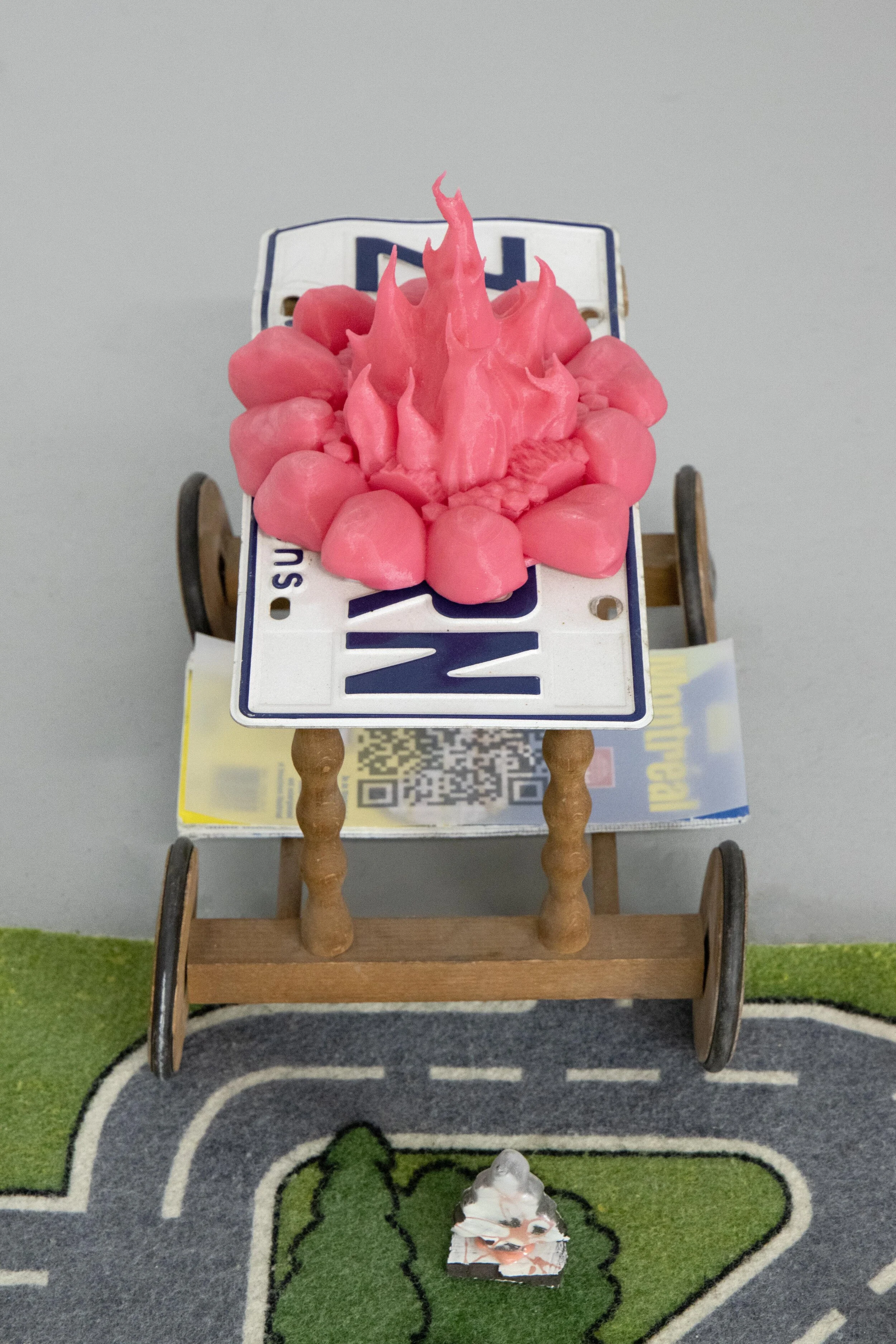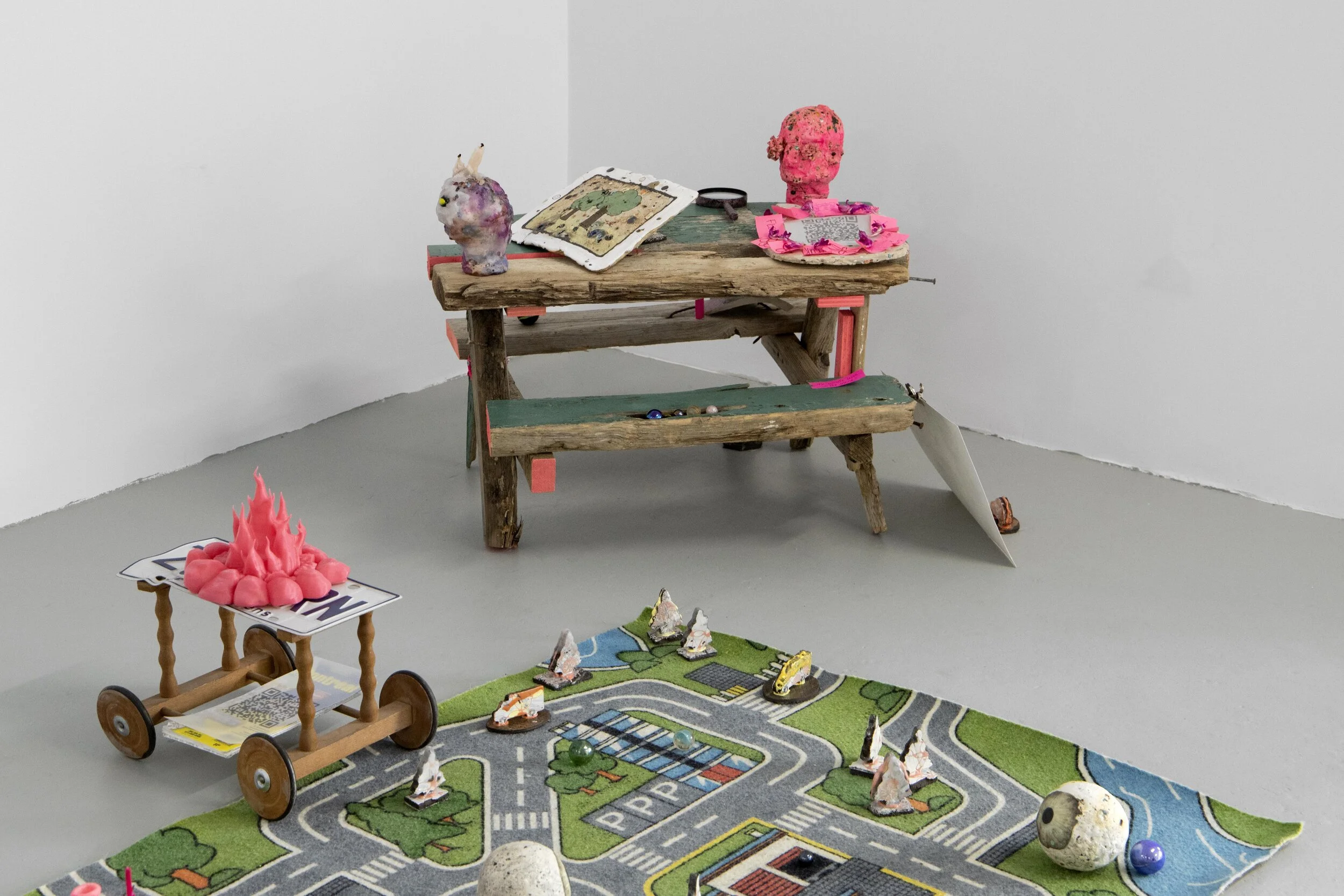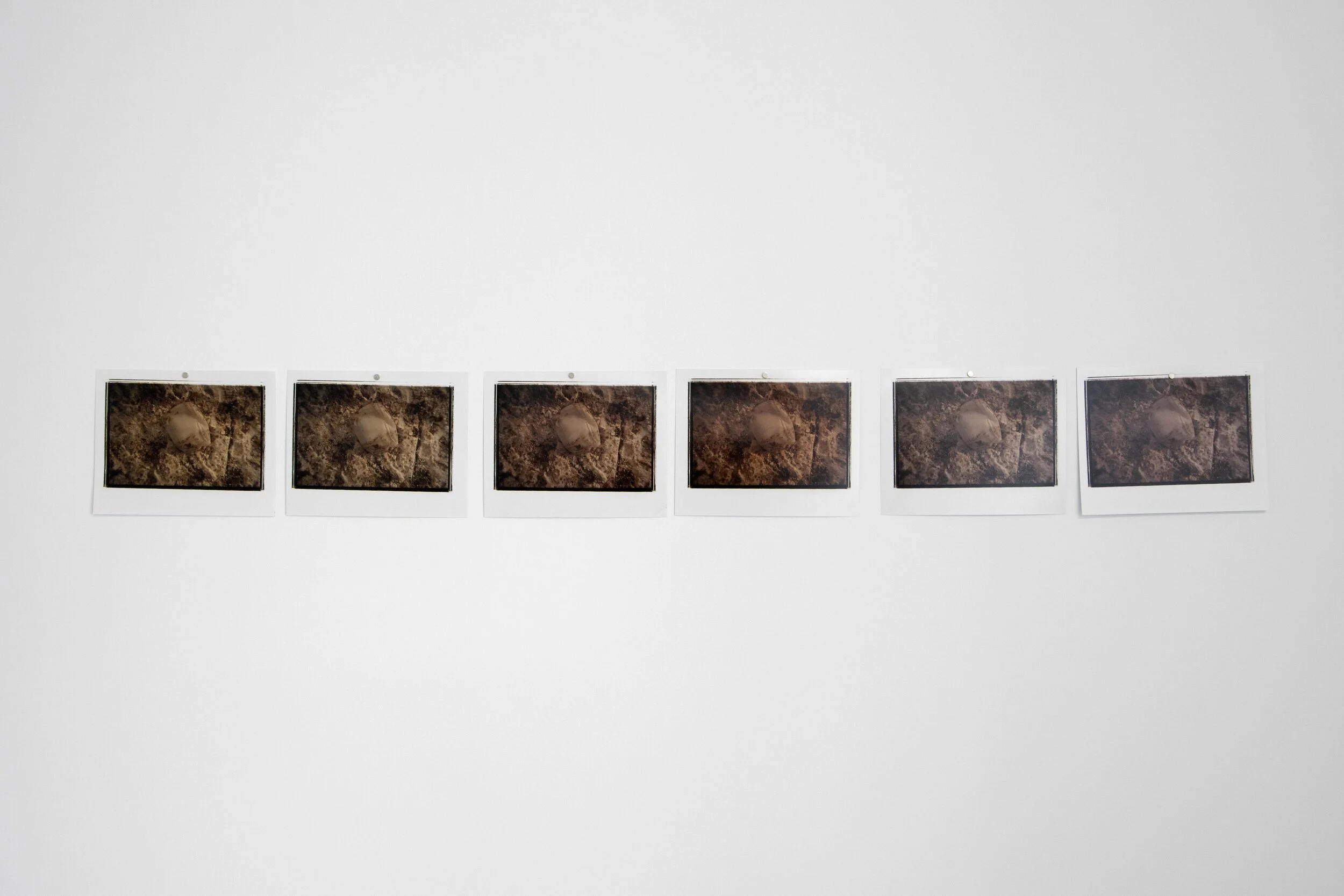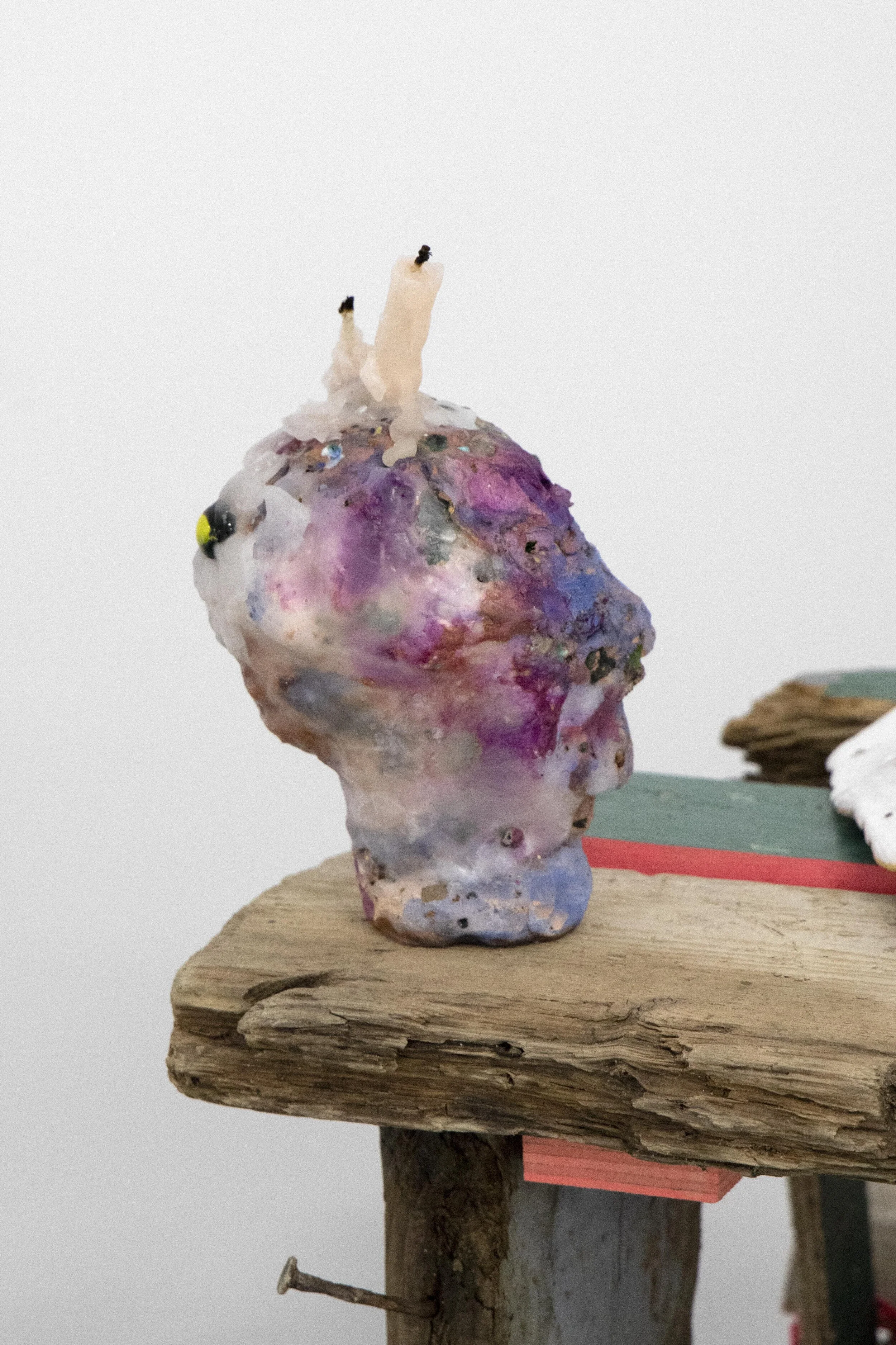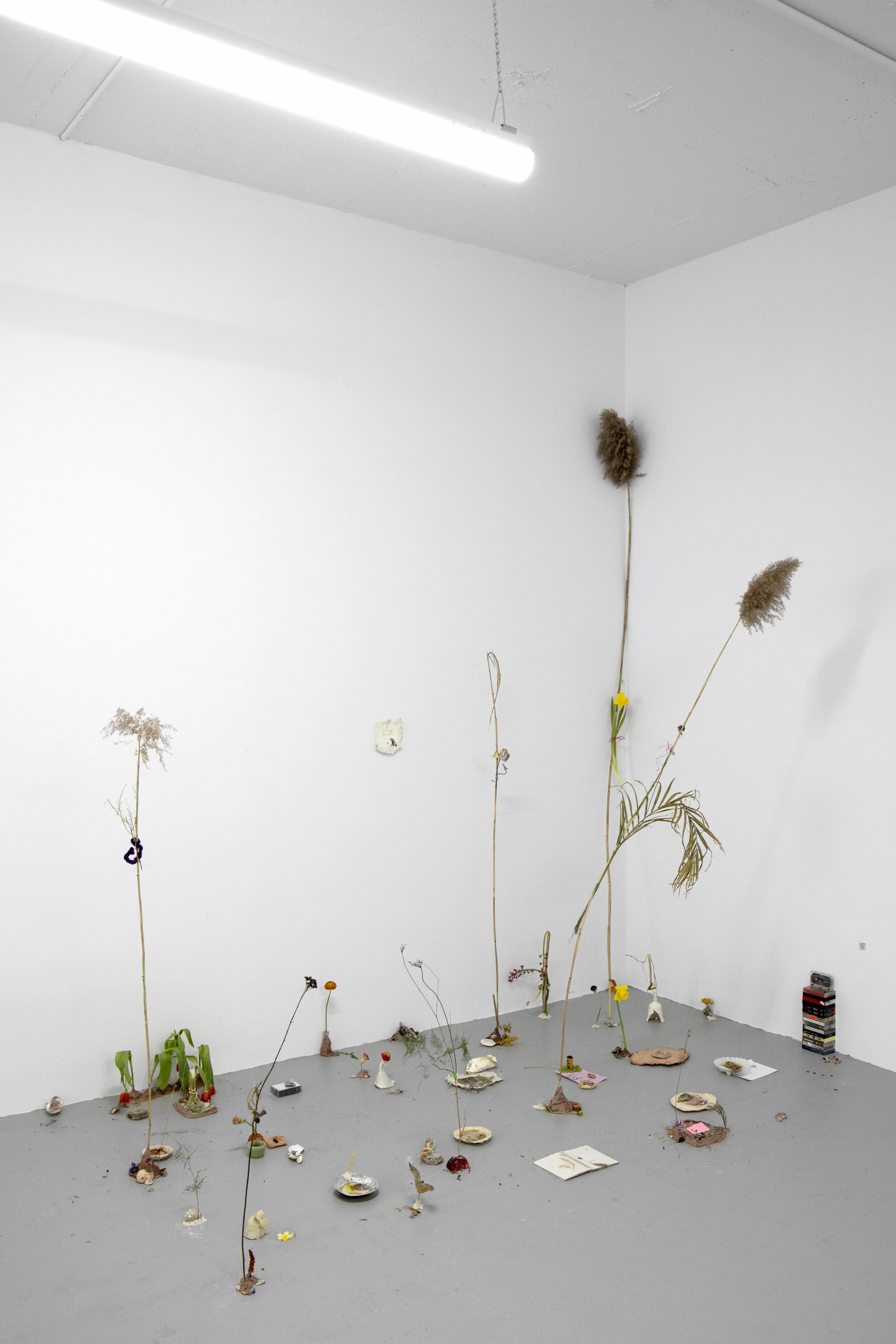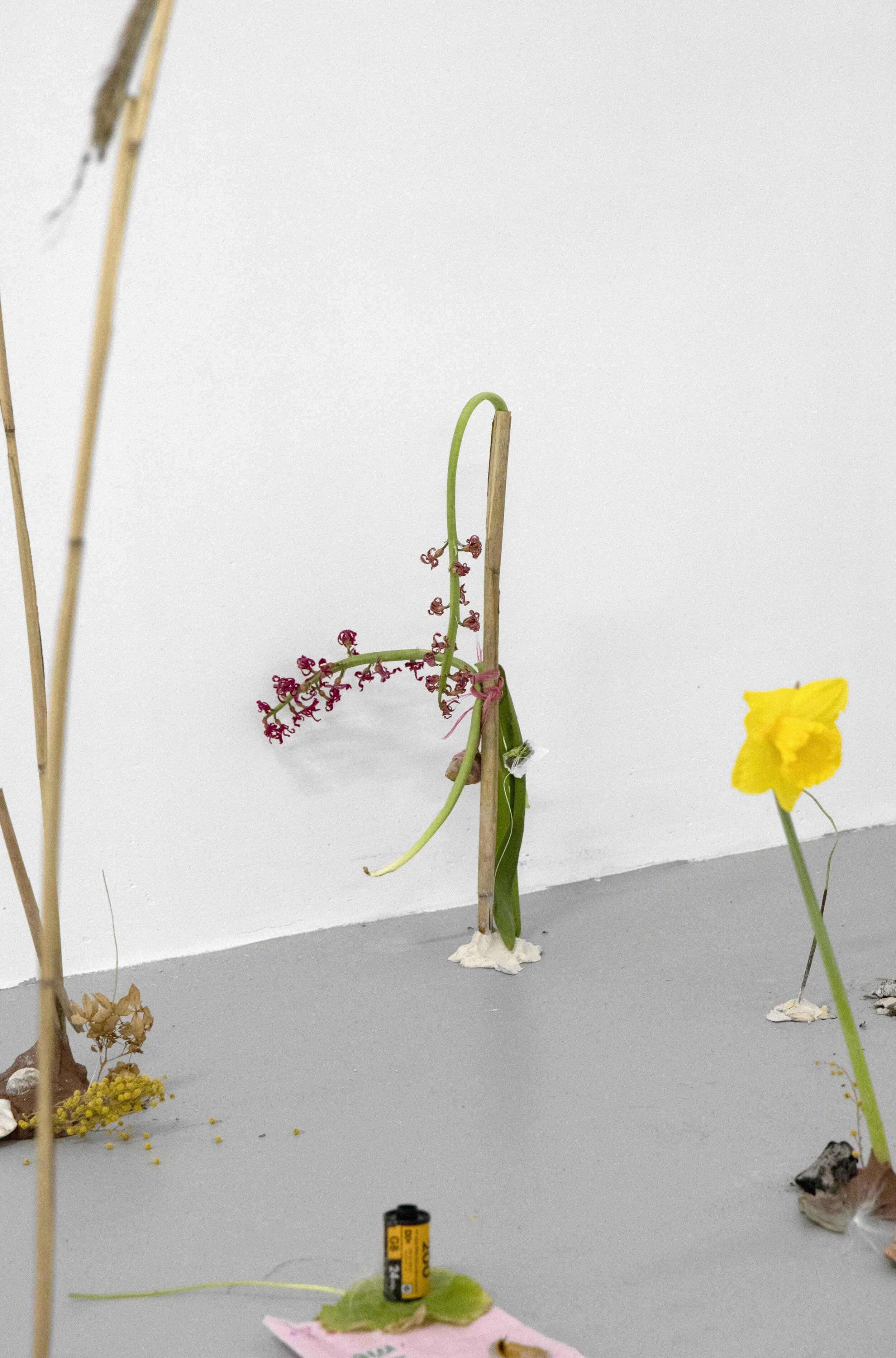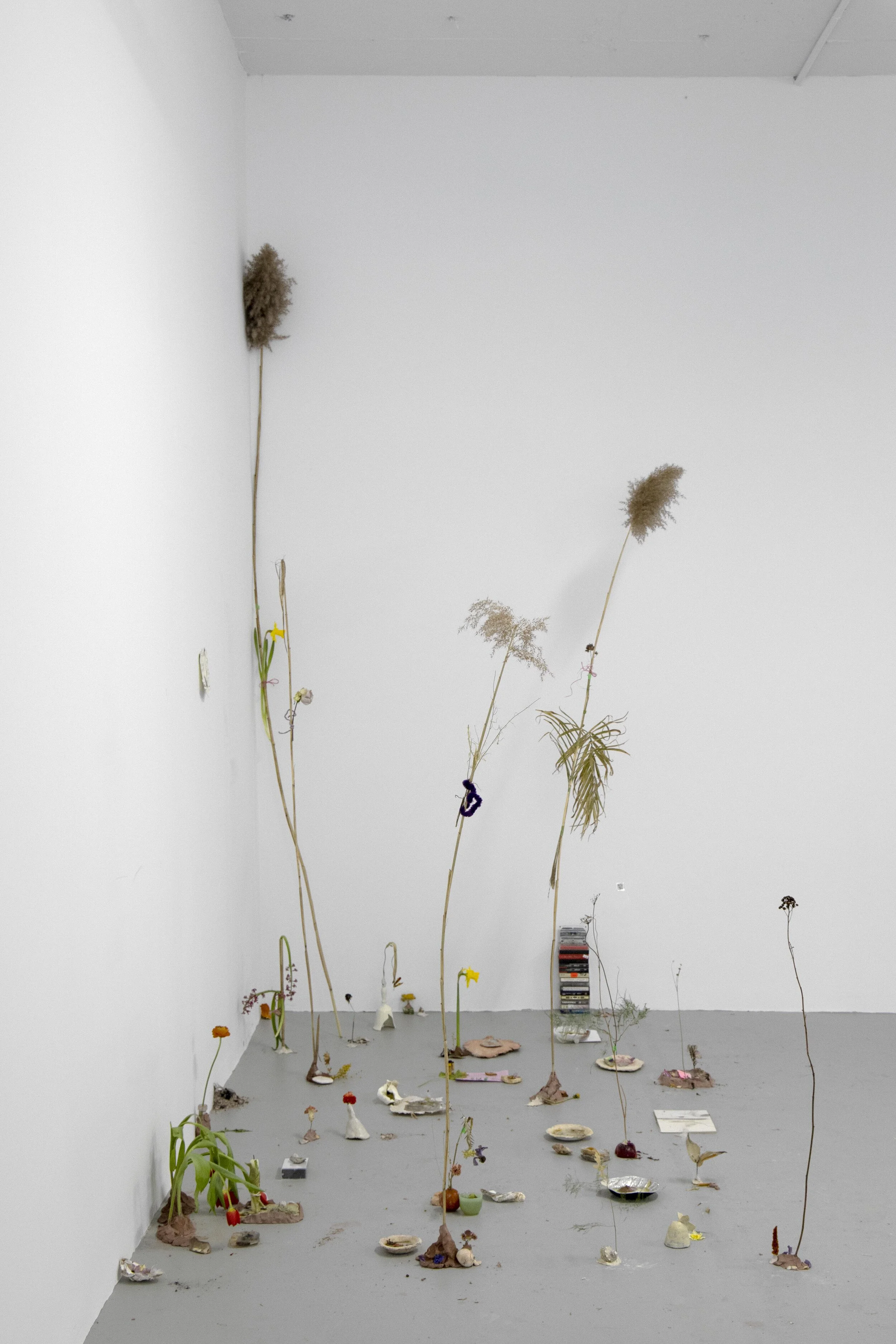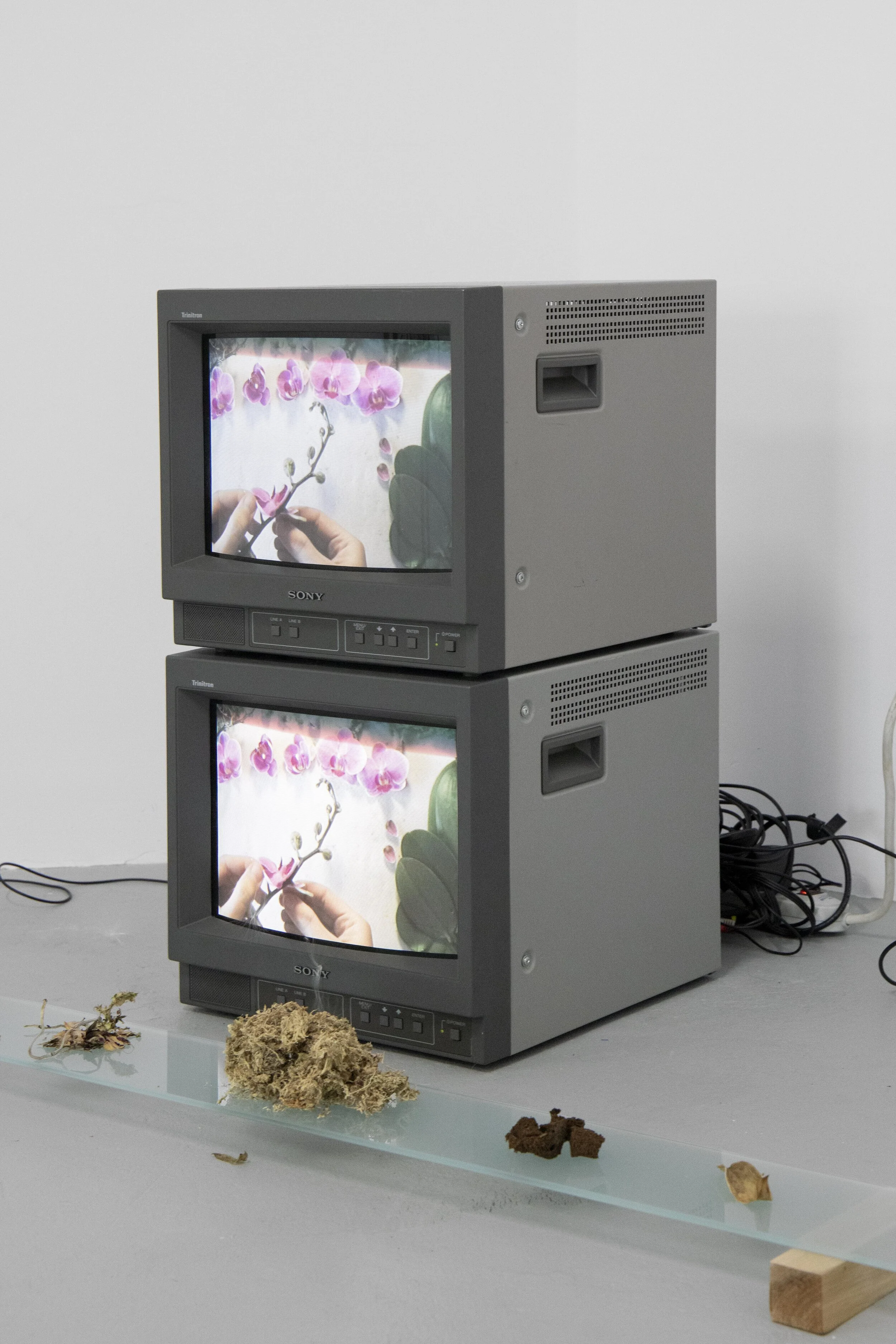Sweet Backpack Poetry 2
Sweet Backpack Poetry is a series of two exhibitions presented by students enrolled in advanced Sculpture classes at Concordia University.
The exhibiting artists are grateful to the Concordia Fine Arts Student Alliance (FASA), Concordia Council on Student Life (CCSL) and The Concordia University Alumni Association (CUAA) for the project funding awarded to this exhibition series.
All Exhibition Photos by Brandon Brookbank.
Exhibition Essay
The title for Sweet Backpack Poetry, a group exhibition by twenty-three undergraduate Sculpture students from Concordia University, was chosen via a game of exquisite corpse. This collective game of chance was an appropriate device for a show that concluded an academic year in which so much was determined by forces beyond any of the participants’ control. The Coronavirus pandemic has enforced a shared context of experience that overrides any of the factors of influence that one normally expects in the course of art school, a common denominator that unites the works in this show despite the fact that most of the artists involved have only ever interacted via Zoom classrooms and only met their instructors in person during the process of installing this exhibition, if at all.
Sweet Backpack Poetry, then, nods to the ephemeral and nomadic nature of the host gallery, Soft Square, as well as to notions of change, adaptability, and resilience, along with the fact that many students had to transport their work to the gallery themselves, often in actual backpacks (the installation was carried out by instructors Juan Ortiz-Apuy and Kelly Jazvac according to students’ instructions). As one artist commented, “I think it’s a nice testament to the spontaneity required to create art in an academic setting through the pandemic; chaotic, strange but still somehow hopeful.”
Many of the works involved emerged from and speak (though often indirectly) to the drastic impact of the pandemic and the limitations it imposed: on social connection and interaction; on studio space (many participating artists reported working at home, in their living space, or outdoors); and on access to tools, materials, and resources. Many students understandably chose to relocate away from Montreal during the term, and even those who remained close to the university were only able to access specialized workshops, fabrication, equipment, or training via limited appointments, forcing many to experiment on their own. Nevertheless, some students recounted finding solutions in collaboration, cooperation, and mutual aid, getting assistance, transport, materials, and supplies free or on loan from classmates and strangers.
Despite the exhibition’s open framework and absence of curatorial intervention, it is easy to trace certain commonalities among the included works. There was a preponderance of found, foraged, recycled, and reclaimed objects (often perishable or organic), and an emphasis on hands-on and materials-based processes. Viewers encountered an ethos of making do with what’s at hand, of meaningful gestures and care for objects related to personal histories and memories, a general attitude of being led by intuition rather than a plan. One student listed keywords including “archive, observance, care, curiosities, crafting.” Insofar as discourses of materiality, care, and precarity were already current in contemporary art, the pandemic seems to have redoubled the emphasis, exposing neoliberal capitalism’s gaping fissures even more nakedly than before.
Among the works on display, there was a general absence of high-tech materials and precision techniques, and those that did employ kinetic elements including motion, light, and sound did so in a comic and absurd register that in some cases shaded into a low-tech sci-fi/horror grotesque. There were also a handful of pieces that could be called dioramas (a fairly neglected form in recent sculpture), notable in that they seemed to affect a pantomime of social interaction as something rendered strange, awkward, even horrifying—how many of us have forgotten how to be “normal” in the company of others?
Overall, the exhibition testifies eloquently—even yes, poetically—to the challenges of producing art in this uncanny lacuna period in which the overarching frame of the international contemporary art world, writ large, has felt strangely absent or unreal, forcing a turn towards inwardness and immediate circumstances. The uncertainty about what sort of art world will return post-pandemic, even a kind of crisis of faith, was also palpable in aspects of this show. At the same time, the resourcefulness and resilience on display were heartening. The “sweet” part of Sweet Backpack Poetry lies in its apparent hopefulness for the future, the promise, as one artist put it, “of better days, an idea of care and comfort that could still be found through art of mutual help.”
Text by Saelan Twerdy.
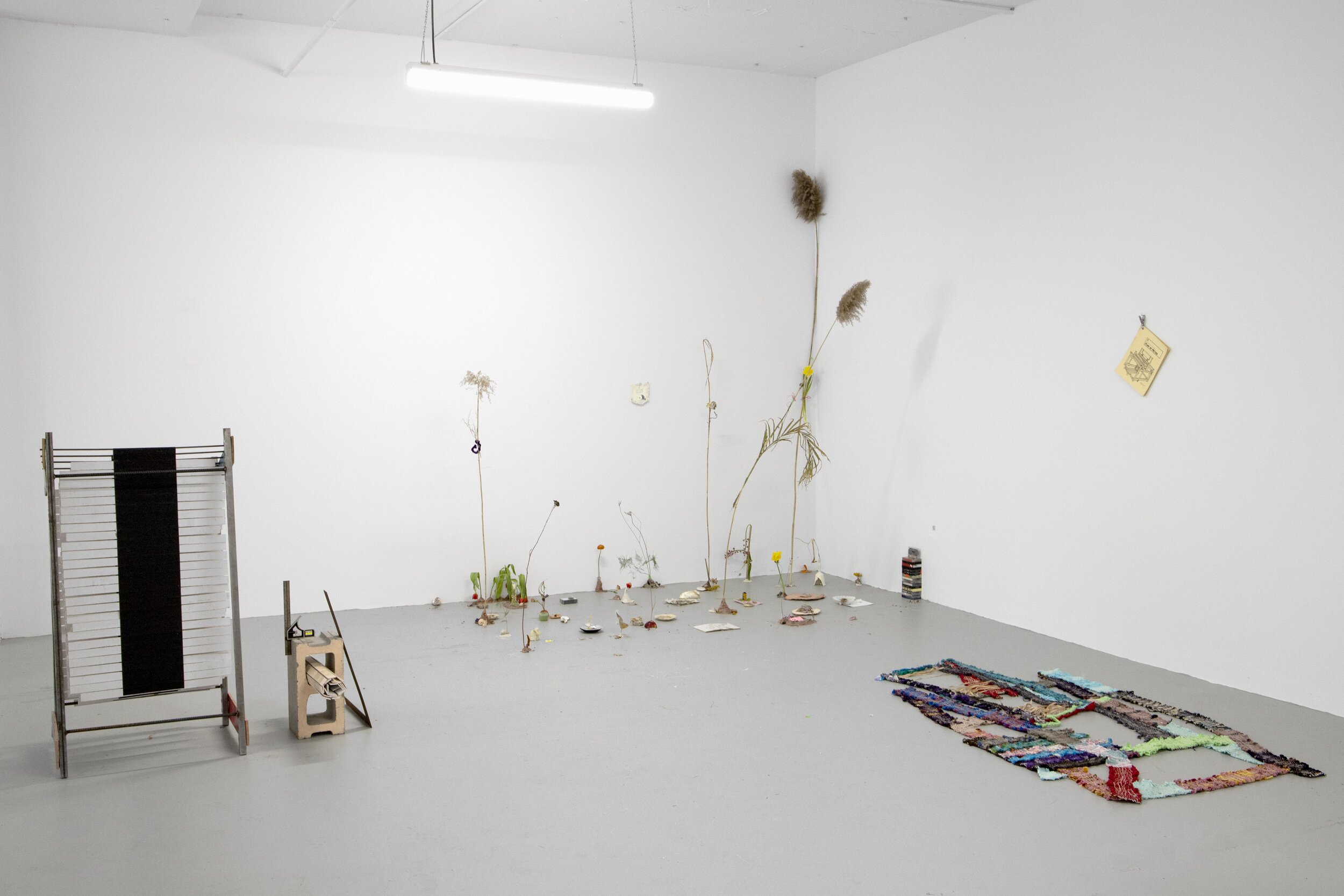

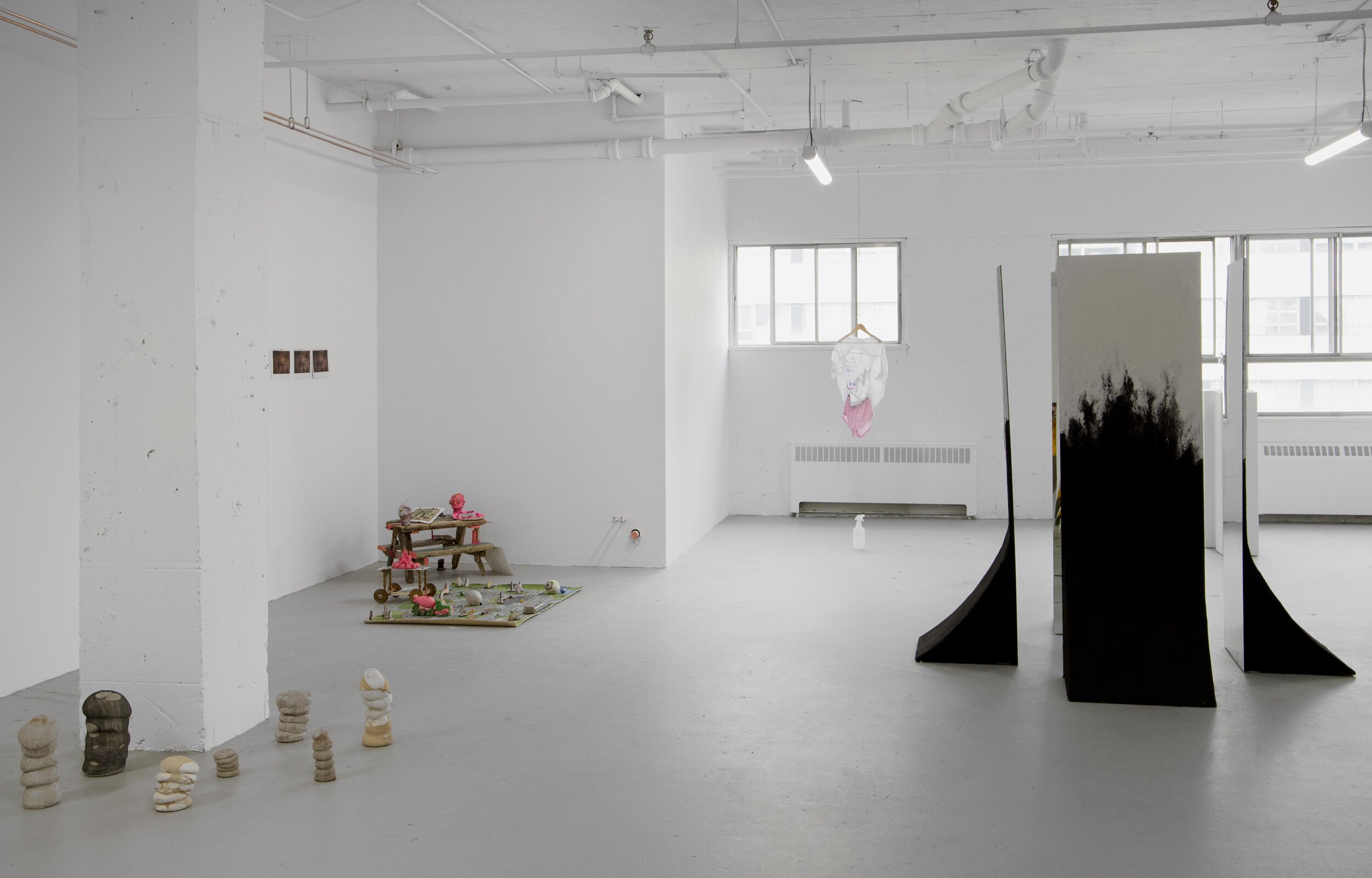

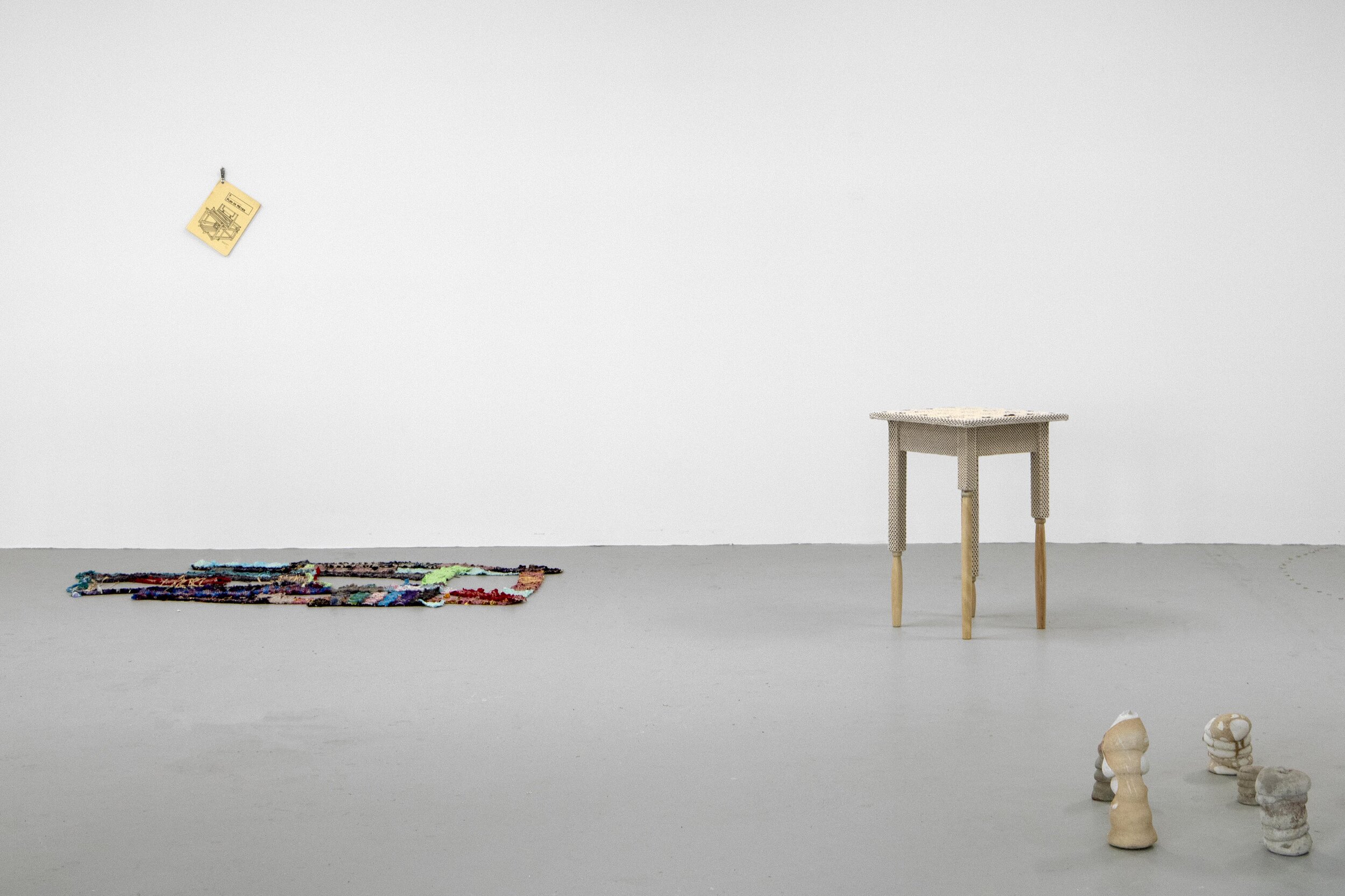
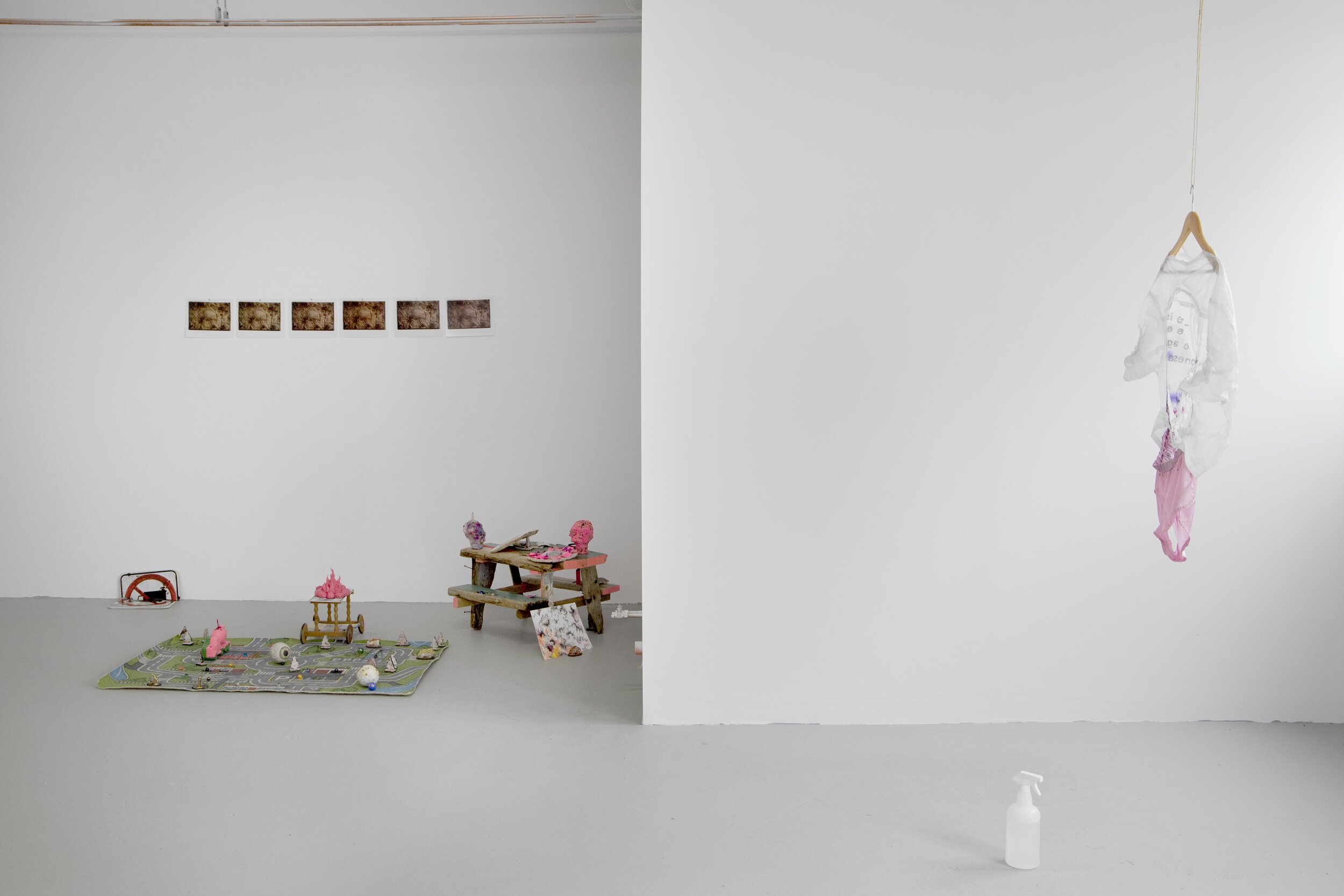


Participating Artists
Alicia Turgeon / Antoine Corbeil / Avery Zhao / Émile Phaneuf / Emy Gagnon Gélinas / Helen Park / Lilianna White / Lori Verret / Loriane Thibodeau / Naomie De Lorimier / Sonia Reboul
Enter Exhibition
↓
Alicia Turgeon, Soft Loom, rag yarn from the artist mother and grandmother's scarf collection
Alicia Turgeon is a multidisciplinary and neurodiverse artist based in Montréal, Québec. She is a BFA candidate in Sculpture at Concordia University where she was recently awarded a Sustainability Research Award (2020) and an Experimental Learning Grant (2020-2021) for her creative pursuits on the boundaries of authorship through opendesign and DIY praxis. Upcoming shows include Past & Future a local group exhibition at La Station a Mies van der Rohe designed former Esso gas station.
The weaving piece Soft Loom is part of a larger investigation by the Turgeon titled Handle with care. In this series, Turgeon explores found objects through the lenses of critical intimacy and radical care. It is a careful and sensitive exploration of used materials; collection, peeling back layers, fragmentation, re-purposing, and re-evaluation. In Soft Loom, Turgeon presents a similar occurrence, by making the choice to use fibers to follow blueprints found among her late grandparent's belongings, she is deviating from a formal representation of the object, a floor loom, and moving it away from its primary function. As much of a family portrait than a self-skilling process, each piece of soft material used, from her matriarchs’ old scarfs to decades old stored-away fabrics, speak of generational gaps, untaught skills and the unassumed sides of reconciliation.
Antoine Corbeil, The Rite of Love, dissolvable fabric interfacing, satin fabric, ink, hot water, spray bottle, hanger, twine, poem
Antoine Corbeil is an interdisciplinary artist— he usually aligns his art work with writing, presented as both sculptural and performative. Born and residing in Montreal, he is a recipient of a degree in Anthropology. He is currently enrolled in a Bachelor of Fine Arts (Studio Arts) at Concordia University and will be graduating at the end of April, 2021.
THE RITE OF LOVE is a performative video where the author acts as his own canvas of poetry. The artist walks in a studio wearing handmade clothes with a poem written upon them. As he walks, water is poured down on his body, slowly dissolving the clothes: the poem fades away as it is simultaneously read in voice -over.
love romance, but I see it as dead poetry— of stories encapsulated within: literature, fictions, movies and song… and what about it? Playing with the theme of love and relationships, —covering subjects such as queerness, identity, sexuality, loss and fragility— writing poetry became the support for the sculptural and performative within my work. —There is no love more eager than the agency of ones’ aegis— AKA The Grief of Love
Avery Zhao, Invisibility Cloak, lenticular printed advertisement sheets, polyester lining, tape, thread, metal pegboard
Avery Zhao-Djokic was born in Beijing, China, and at the age of five her family moved to Ottawa, Ontario. She has studied Design at Ryerson University and graduated from the Grande École ESMOD in Paris in Fashion Design. For several years following her degree, she worked as a fashion designer in Paris and Montreal for major international brands, with her work resulting in research trips around Europe, Asia and the USA.
Zhao-Djokic’s practice includes painting, sculpture and action research. She is inspired by experiences living and working in different continents, as well as by sci-fi and economic themes.
Émile Phaneuf, Blind Arch, steel, skateboard decks, grip tape, MDF, latex paint
Émile Phaneuf is a multidisciplinary artist based in Sutton, Canada, whose research focuses on street skateboarding’s relationship to the city. Building on an expanding portfolio of skateable artworks, his recent creations highlight the unique mark-marking resulting from skaters’ détournement of urban space. In the last few years, Émile’s performances and sculpture works have been exhibited at La Station, Somewhere Gallery, Art Matters festival, Art IC!, VAV Gallery, Galerie 2112 and many Concordia University student exhibitions.
Phaneuf’s Blind Arch bears the distinct marks of skate-boarding as seen on urban architecture. They are the index of accumulated trick attempts on a found obstacle. Instead of being labelled a de facto nuisance, these marks could be celebrated as equivalence to freedom of speech: freedom of movement. They are the cryptic symbols of an alternative mapping of the city.
Emy Gagnon Gélinas, Some spaces do not exist, wood paper-crete, mirror, fasteners, Styrofoam, adhesive
Emy Gagnon Gélinas is in her third year of her BFA in Studio Art at Concordia University. Her college studies were previously completed in the visual arts program at Cégep du Vieux-Montréal, where she had the opportunity to be in a group exhibition, and where she also presented her first solo exhibition entitled Fil Conducteur. Her approach of exploring contrasts, movements and illusions continues to evolve, whether in drawing, sculpture or installation.
Through this sculptural installation entitled Some spaces do not exist, Gagnon Gélinas explores the coexistence and fusion between materials such as plaster and concrete, as well as the spaces created by illusions (revealed to those who observe closely enough). Contrasts are present in this work between colors and materials, but also between the solidity and the closed appearance of the structure from an external point of view of the installation, and the openness and the impression of grandeur from an internal point of view. A duality the refore emerges in finding its place between existing and non-existent spaces.
Helen Park, Object of my object’s desire, Plexiglas, found objects, metal plates, 3D printed resin
Helen Park is interested in the juxtaposition between objects that occurs when objects and pictures are alienated from their original place and given them new context. Park is engaged by the natural transformation and disintegration of objects when found in their unnatural habitats and how the journey of the object is written through its wear and tear. Bringing the artificial to the natural, and making the natural artificial, are recurring themes in Park’s work.
I see myself as a collage artist, dabbling in many, master of none. In my sculptures, all my different practices come together into a collage of different mediums. Quiet. Listen. Can you hear the objects? They are having conversations of their own. As a medium between objects and humans, I have been granted special privilege into the world of things. Each with a will of its own, I listen to their desires and help them find their resting place in my coffin of things.
Lilianna White, Surrendering to the Containment of the Infinite, concrete, plaster and nylons
Lilianna White is an interdisciplinary artist from Toronto, Canada. She is Currently based in Montreal studying Studio Arts at Concordia University. White works with sculpture, installation, drawing and the digital arts. Her interest in art history, philosophy and critical theory is what fuels her practice and is reflected in the work that she makes.
Lori Verret, Table, wood, cotton, wood stain, fasteners
Born in Boucherville, Lori Verret is a visual artist working mostly in sculpture and craft. In her BFA at Concordia University, she explores the tension between craft and fine arts as well as the notions of functionality and utility.
A small birch table is partly covered with crochet. The work is concerned with the idea of labor as well as with the tension between what is perceived as feminine crafts and masculine craftsmanship.
Loriane Thibodeau, Time magnifies or overwhelms objects. It is a question of attitude, driftwood, ceramics, selected objects, video and mixed materials
Loriane Thibodeau is an artist whose current base camp is on the island of Tiohtià:ke/Montreal (QC, Canada), but who proudly grew up in the tiny village of Sainte-Félicité-de-L'Islet (Chaudière-Appalaches). In parallel to the questions about the contexts of visual and public art contexts that underlie her individual practice, Thibodeau pursues this specific research with different groups of artists (Caravane BLING BLING!, Collectif En Étrive) and also as a specialist in visual arts and crafts for the Politique d’intégration des arts à l’architecture et à l’environnement des bâtiments et des sites gouvernementaux et publics (1% Law) of the Ministère de la culture et des communications du Québec.
Thibodeau’s sculptures are an echo of life changes with a strong focus on breaking points. Through the amalgam of disparate and precarious components, sudden disasters, passage of time and apathy stories take shape.
Naomie de Lorimier, 12 lunes, bain de céramique aux dimensions variable, cloches, papier, feuilles fraîches, orange, fleurs séchées, pommes, fils trouvés, coquillages de voyage, pétales, savon, cendres, vase brie, herbier personnel, argile crue, séchée et cuite, cire eaux, mousse, verre, roches du Québec, film, cassette, dessins, algues, memo, infusion, mimosa centaurée, phragmite, érythone d’Amérique, jonquilles, tulipes
Naomie de Lorimier is an interdisciplinary musician known as N NAO who has been active on the Montreal underground scene for millions of years. Born in Montreal in 1994, she has been practicing alternative romance ever since, producing songs at the edge of experimental music and singer-songwriting. Through the cyclic rituals of writing, flowers picking, sounds and videos archiving on tapes, she collects her memories so that they last over time. Her poetic compositions inspired by lucid dreams and new places of intimacy are part of a performative approach, at the intersection of music and video. This spring, she will perform at RIPA – Rencontre Interuniversitaire de Performance Actuelle (Montreal, QC).
Sonia Reboul, Untitled, 2 channel video, orchids, cotton, beads, wood, glass, resin, thread
Sonia Reboul is a self-taught multidisciplinary French-Canadian artist currently pursuing a Bachelor of Fine Arts at Concordia University in Montreal after a 12-year career in communications. Over the last two years she has obtained three scholarships from Concordia University Associations and her projects have been selected as part of various initiatives (Les encans de la quarantaine auctions, La collecte COVID organized by Sale Caractère et la Bourgeoise Sérigraphe, the magazine l'Organe, and The Unicorn Factory blog). She has been invited to collaborate with other artistic fields such as the musician Sarah Toussaint-Léveillé, for book cover of a poetry publishing house. She has also taken part in group exhibitions including the Art Matters festival at Gham & Dafe gallery; and two separate exhibitinos at Concordia University’s VAV gallery. In January 2022 she will present her work at La Centrale Galerie Powerhouse.
Sonia Reboul explores our relationship to the plant word through a meditative installation that engages sight and sounds. By inviting us to adopt a posture of ritual, she highlights an unexpected permeability between notions of care and destruction, and interrogates our personal relationship to ecological convictions and ecofeminist practices.


